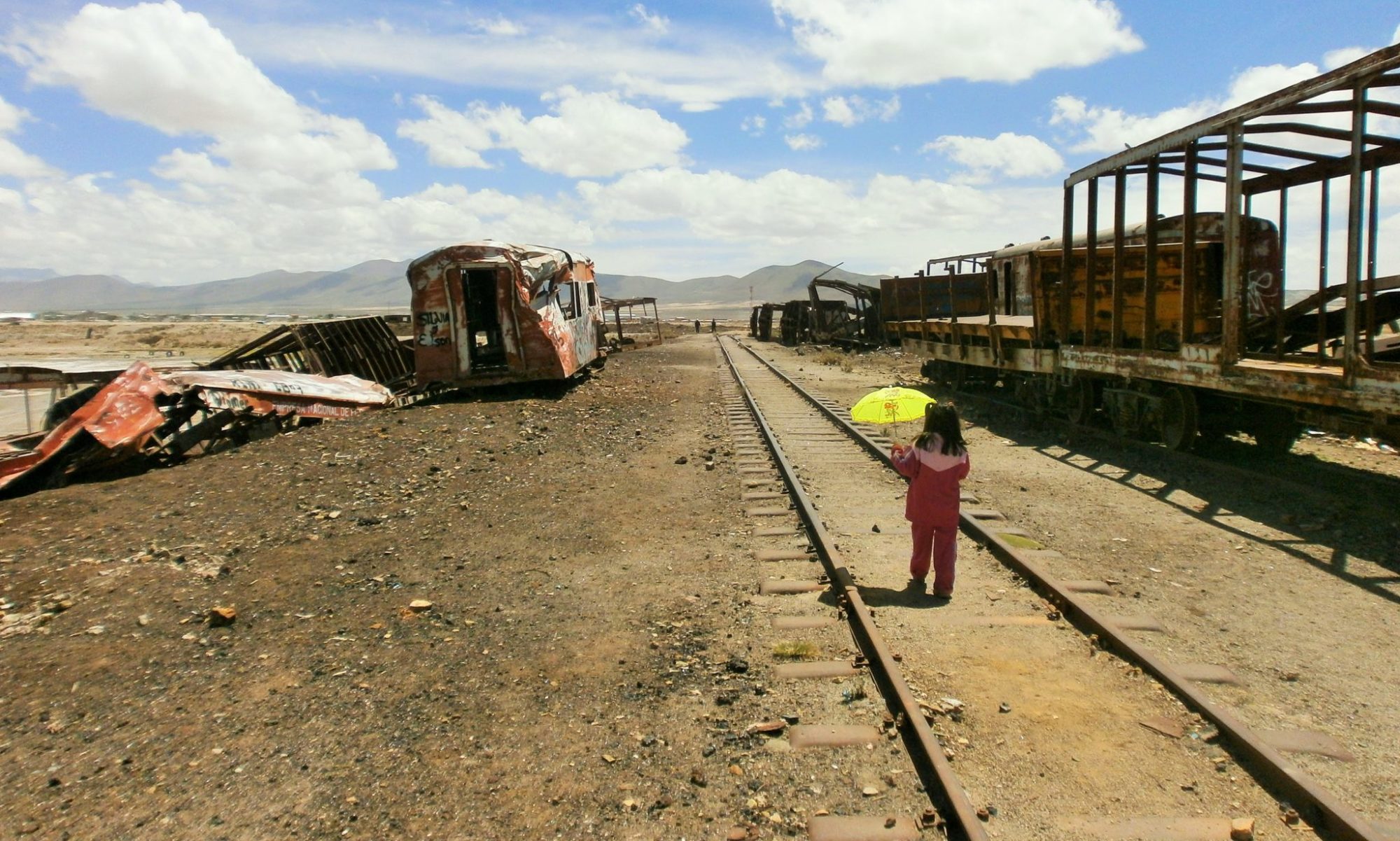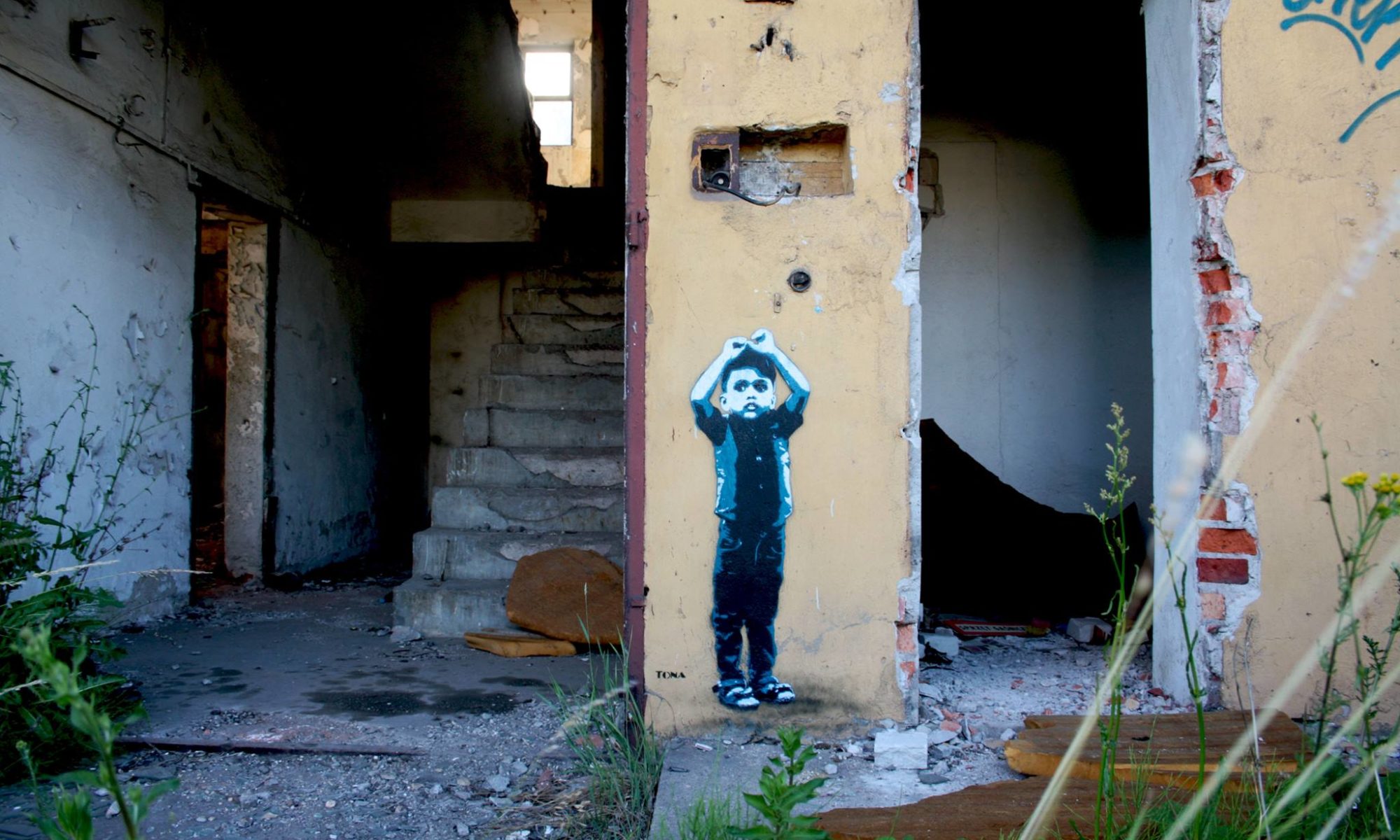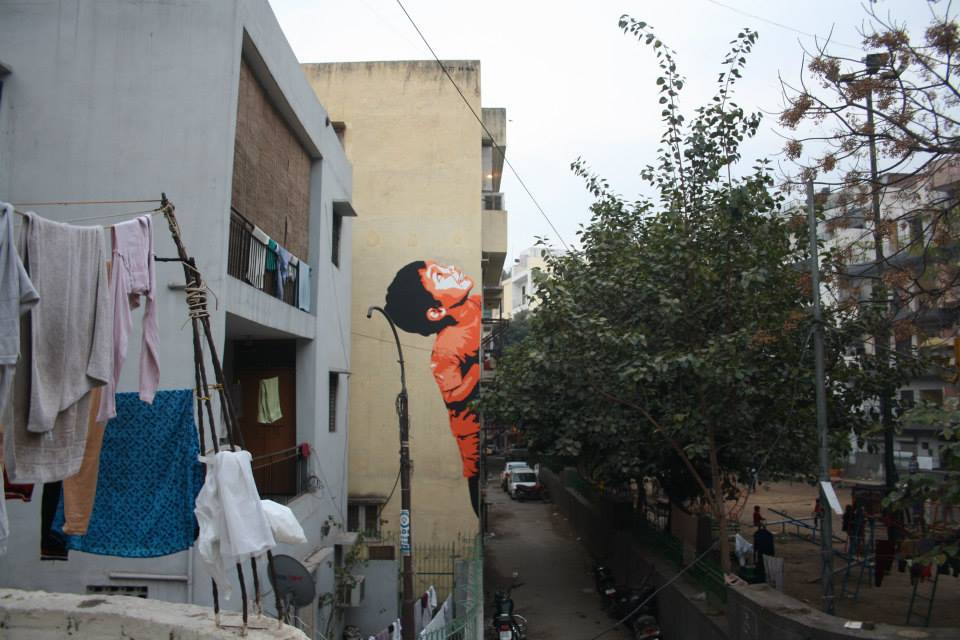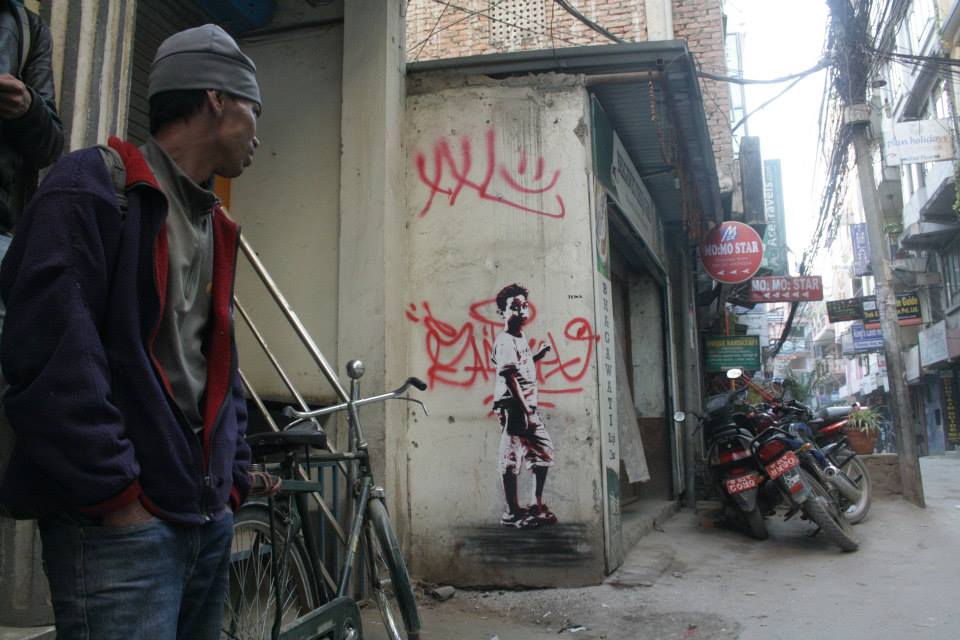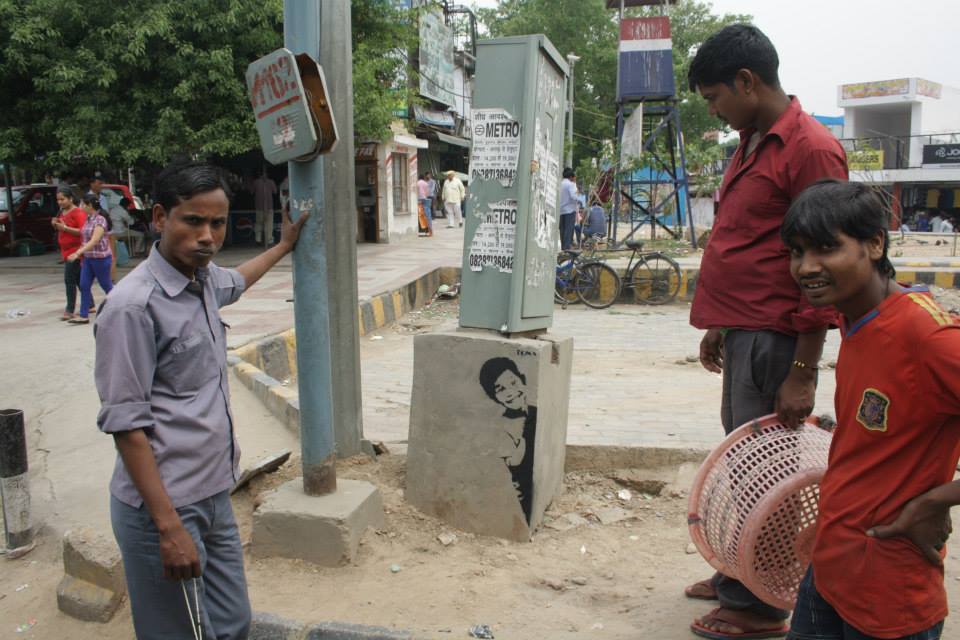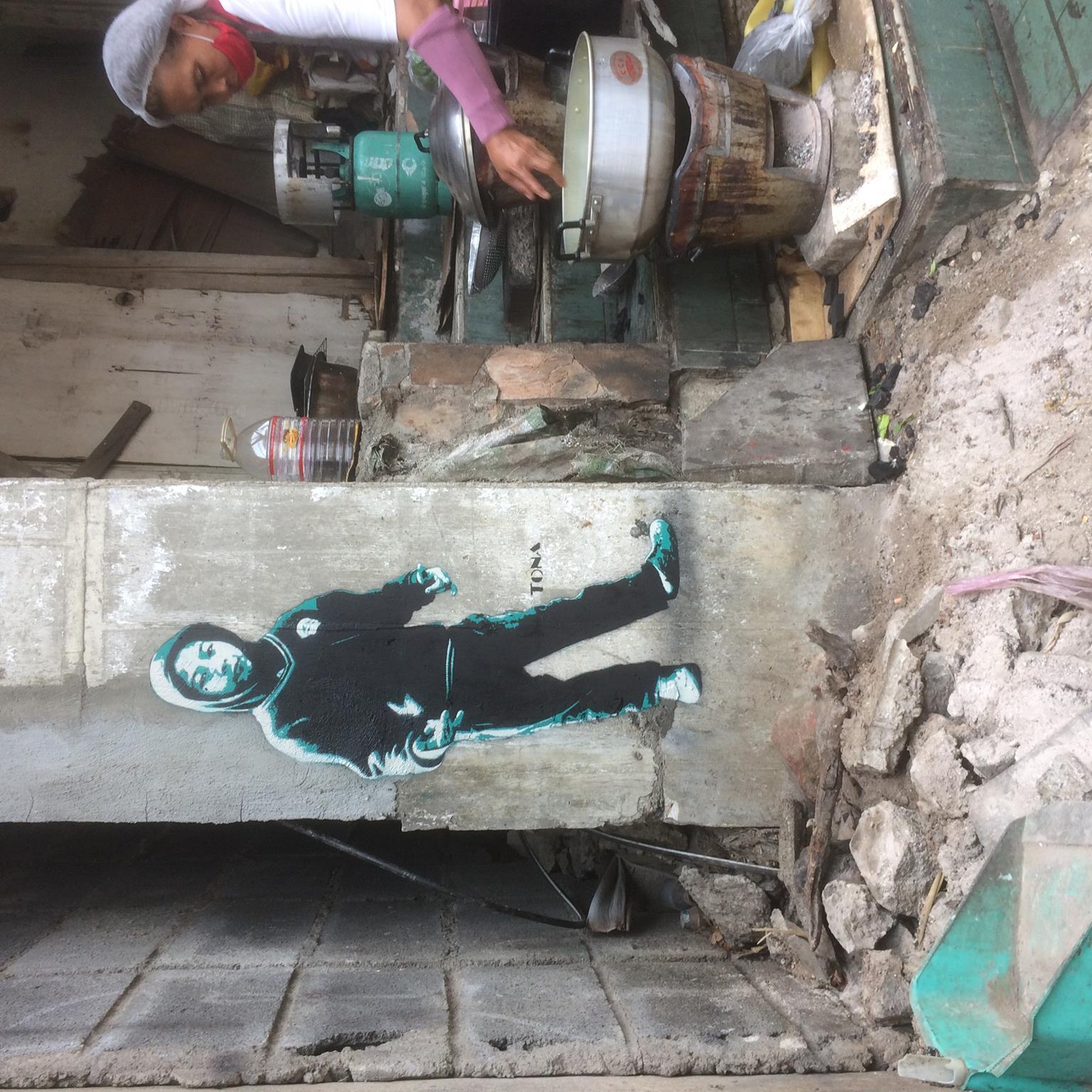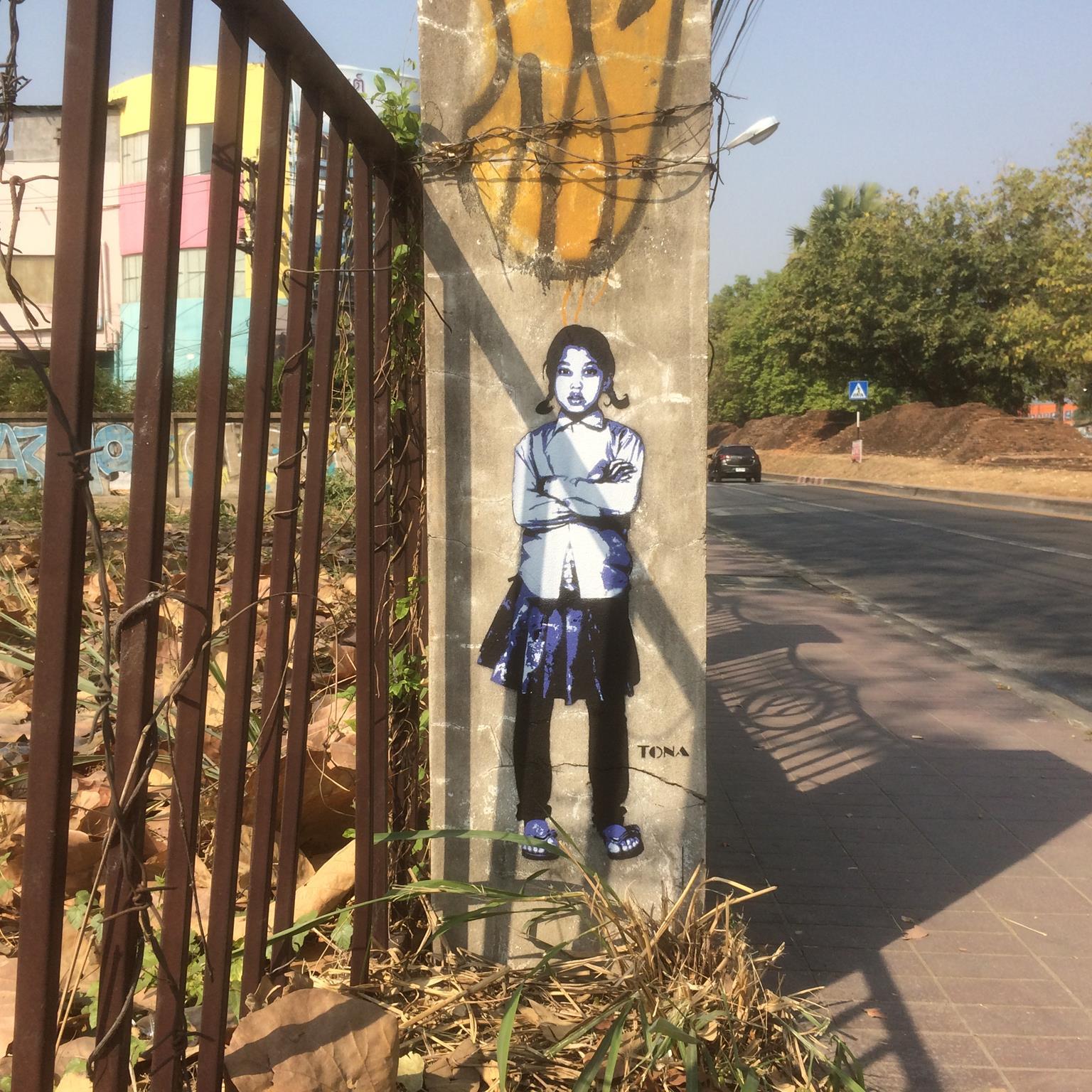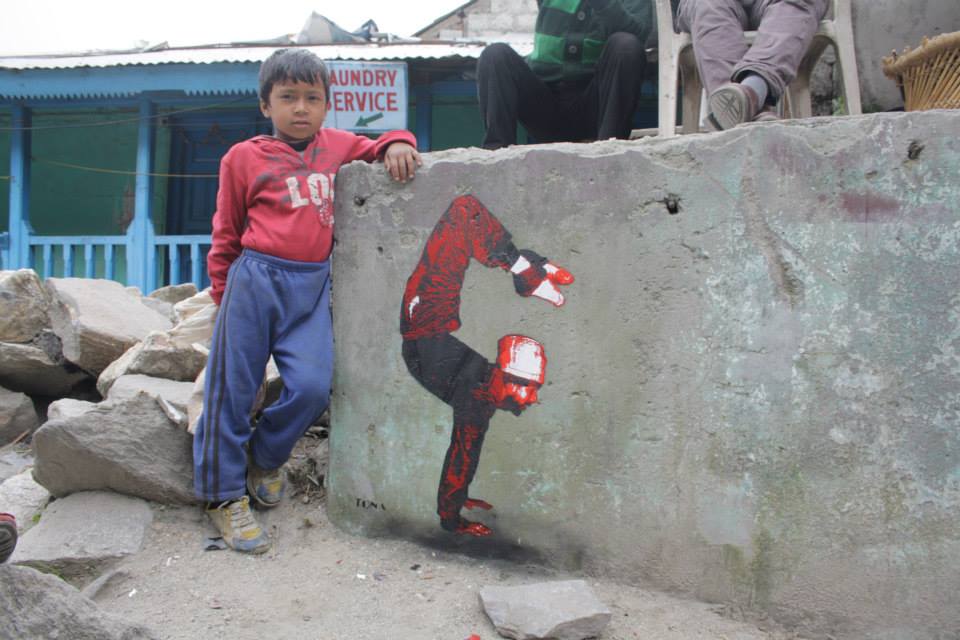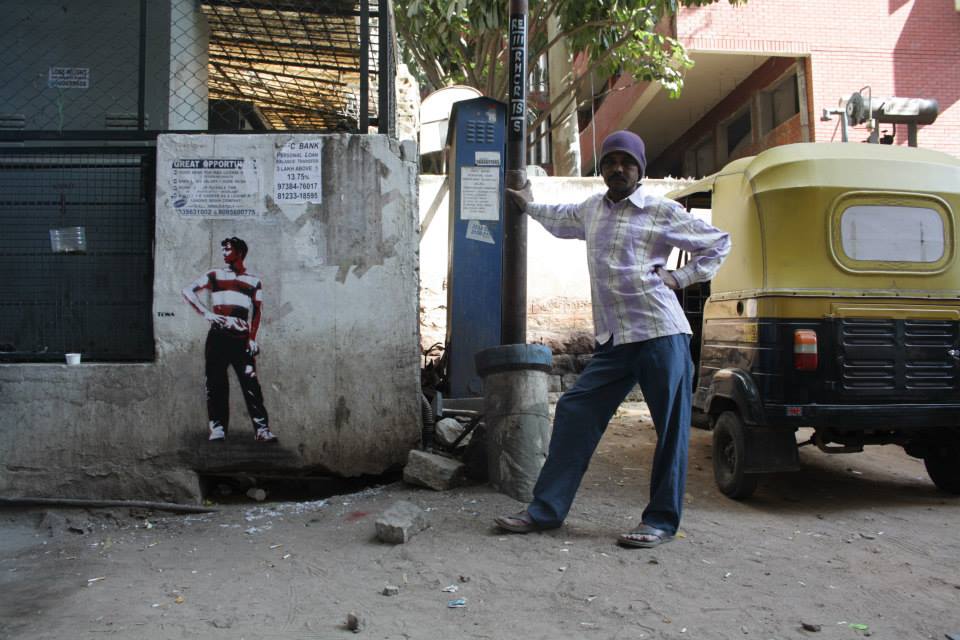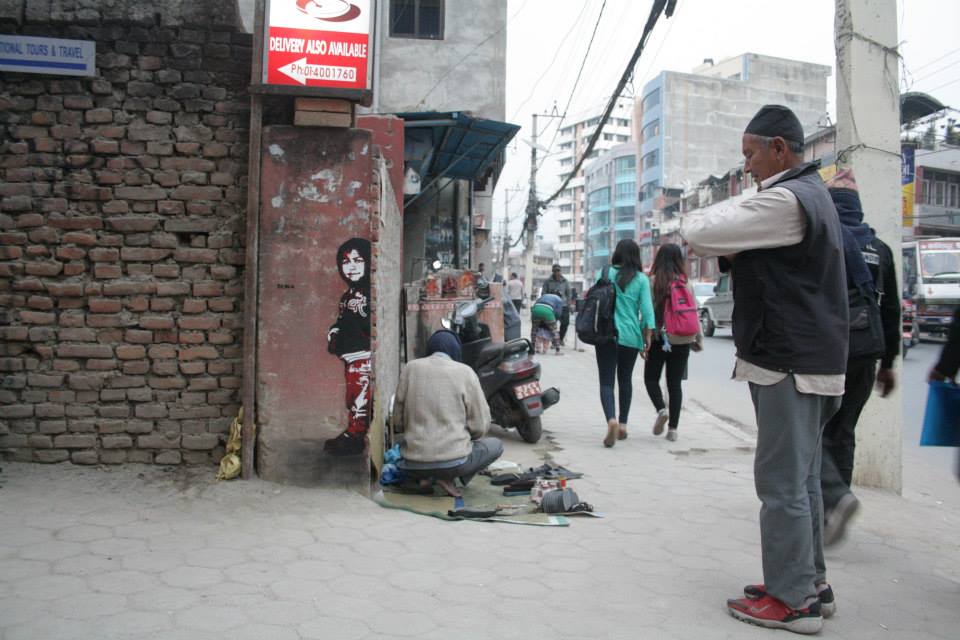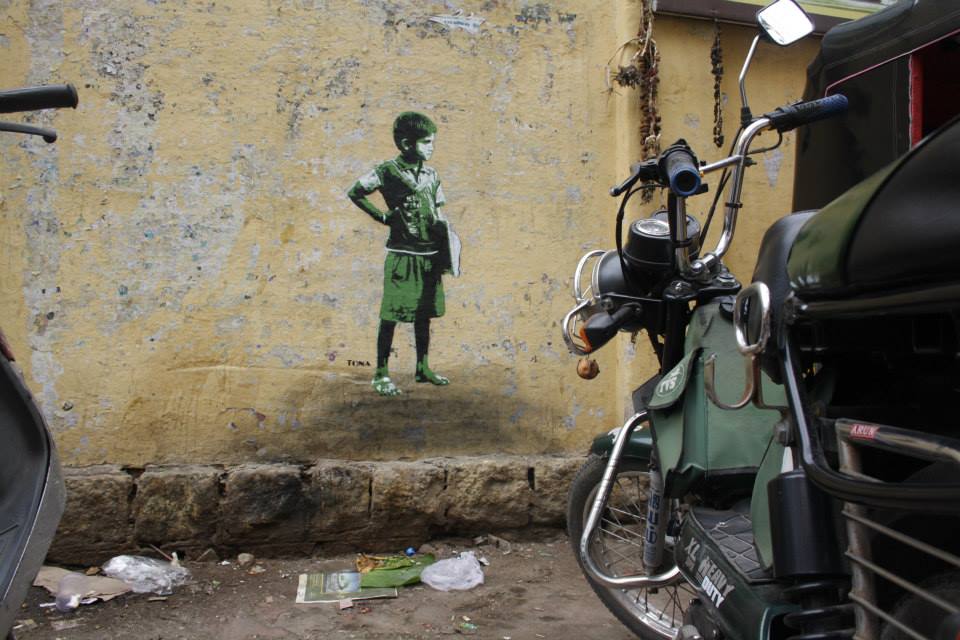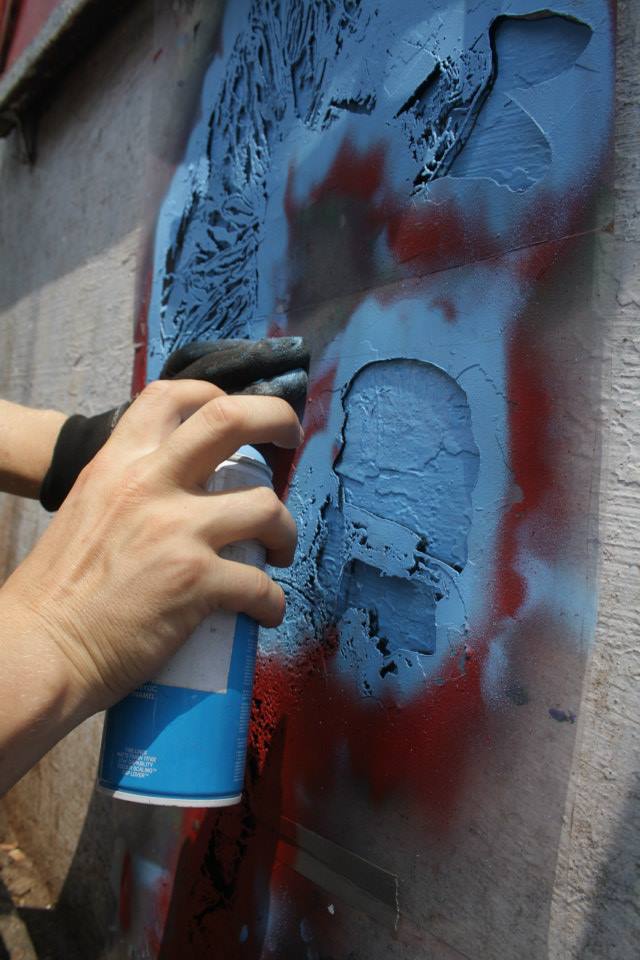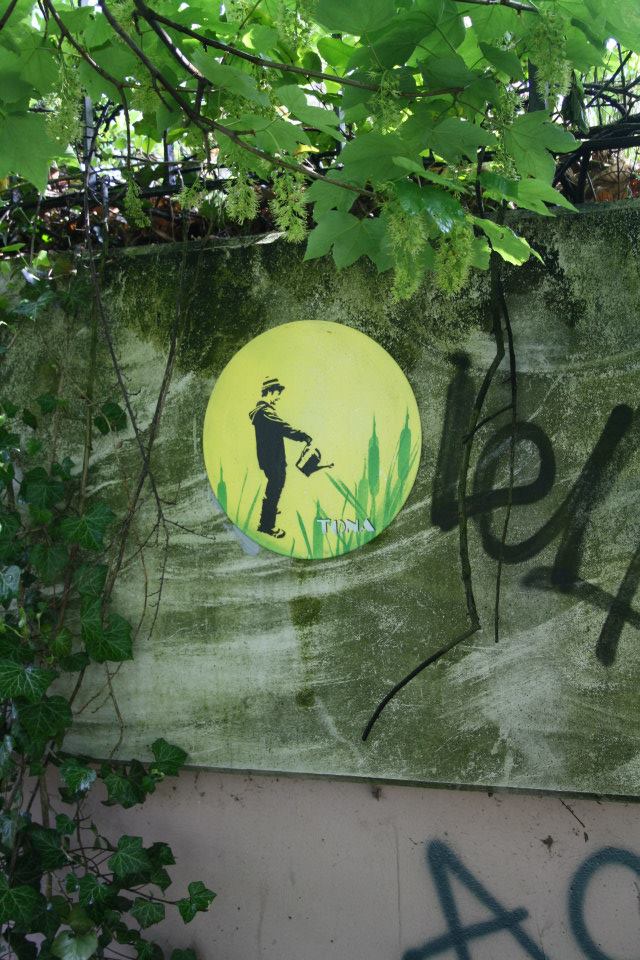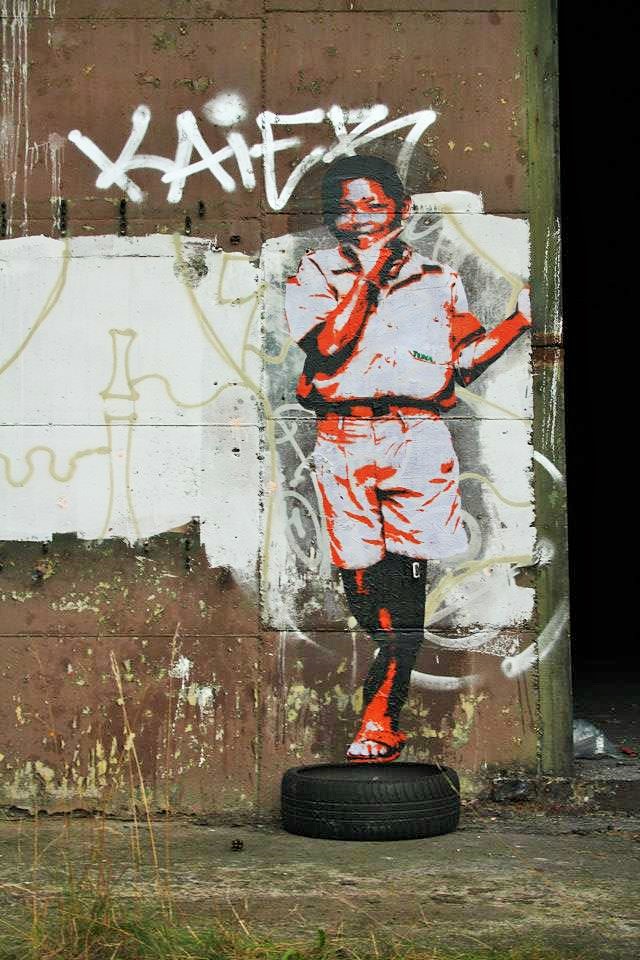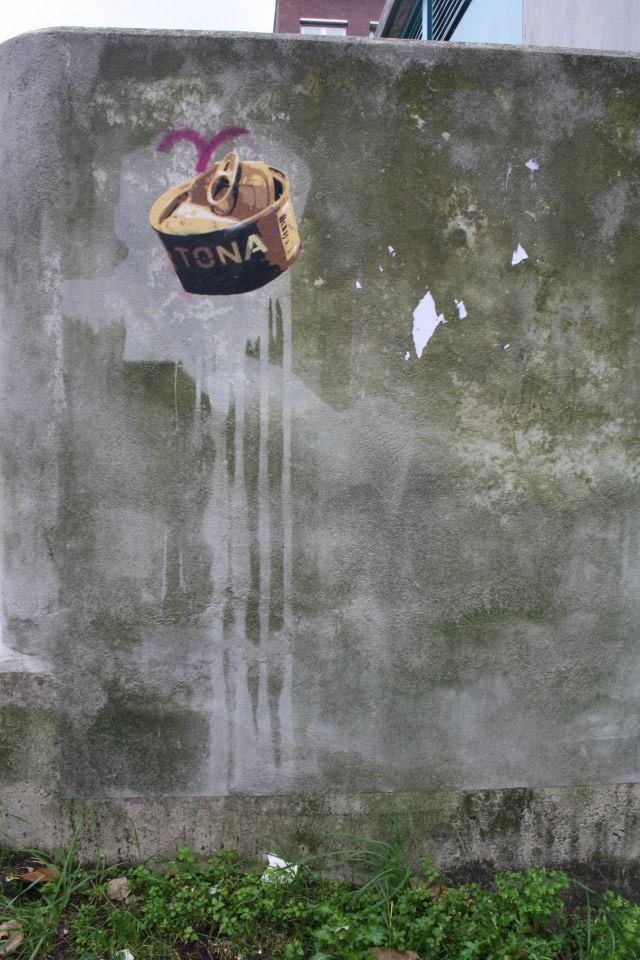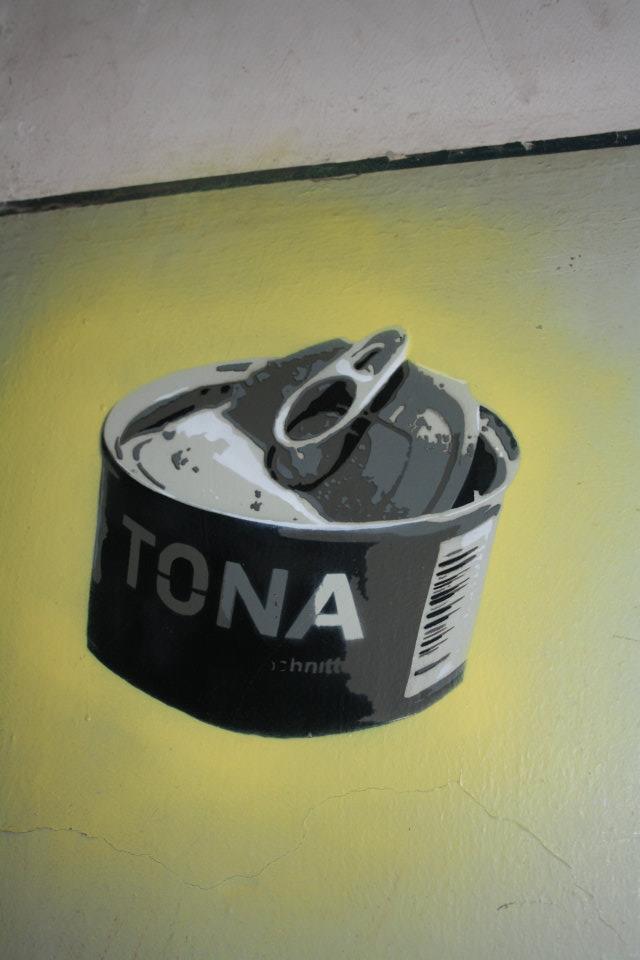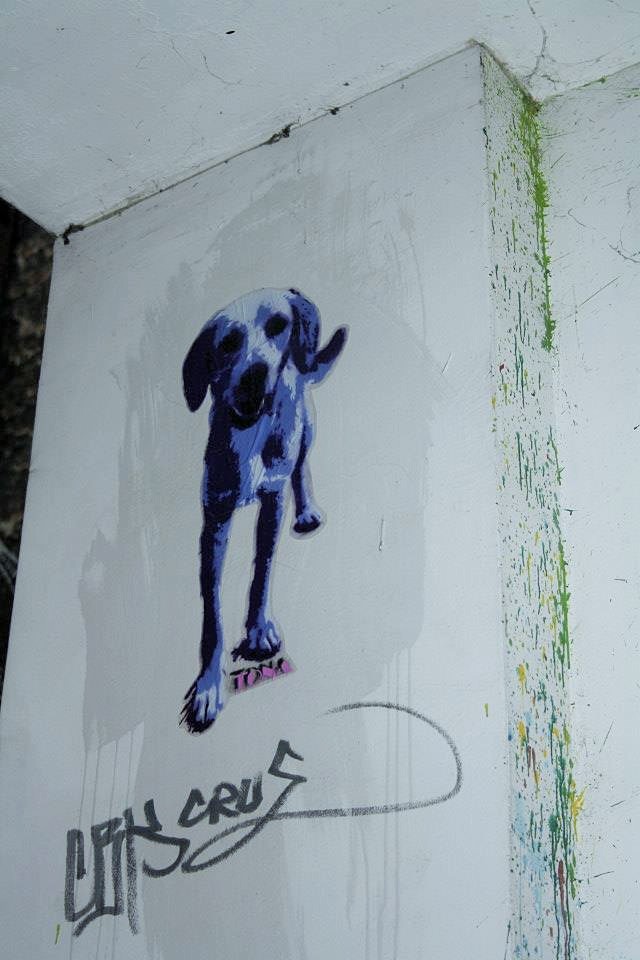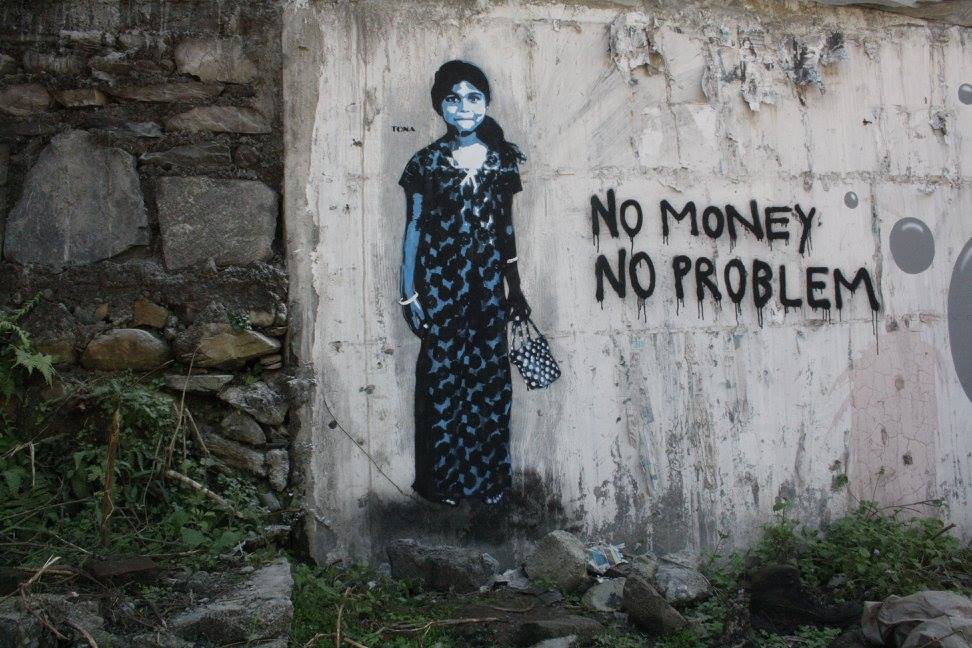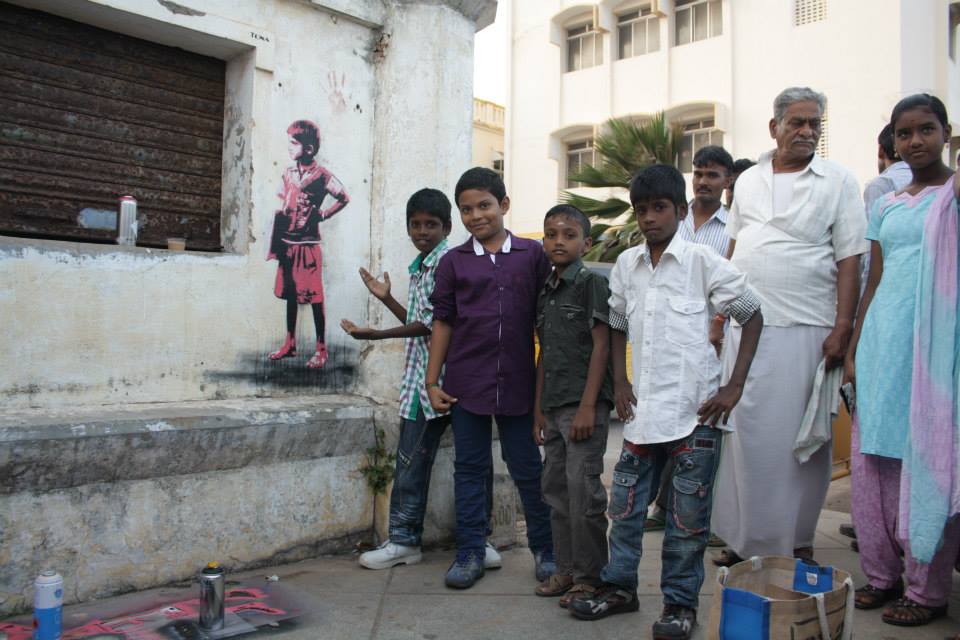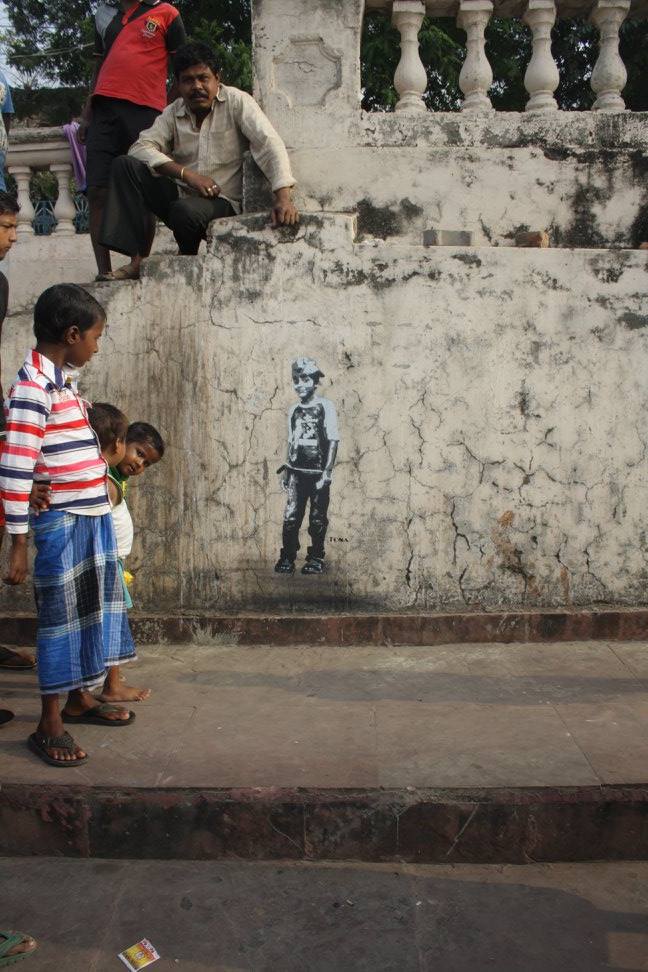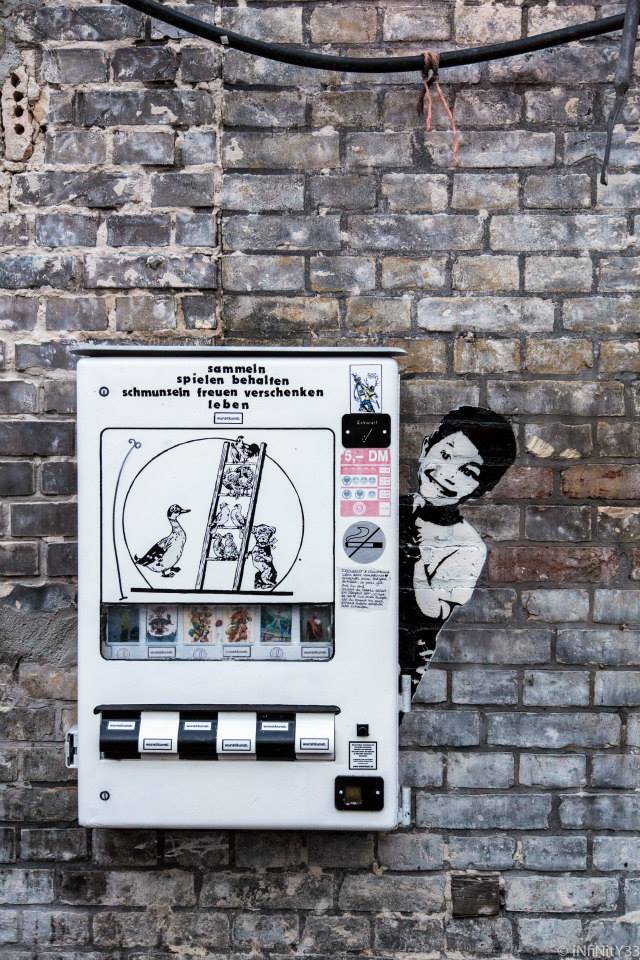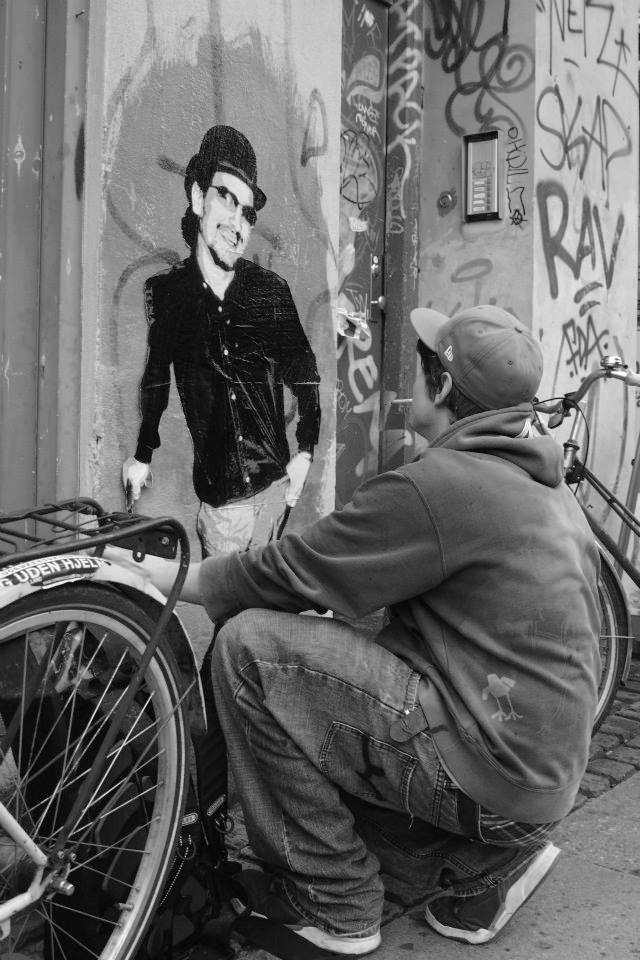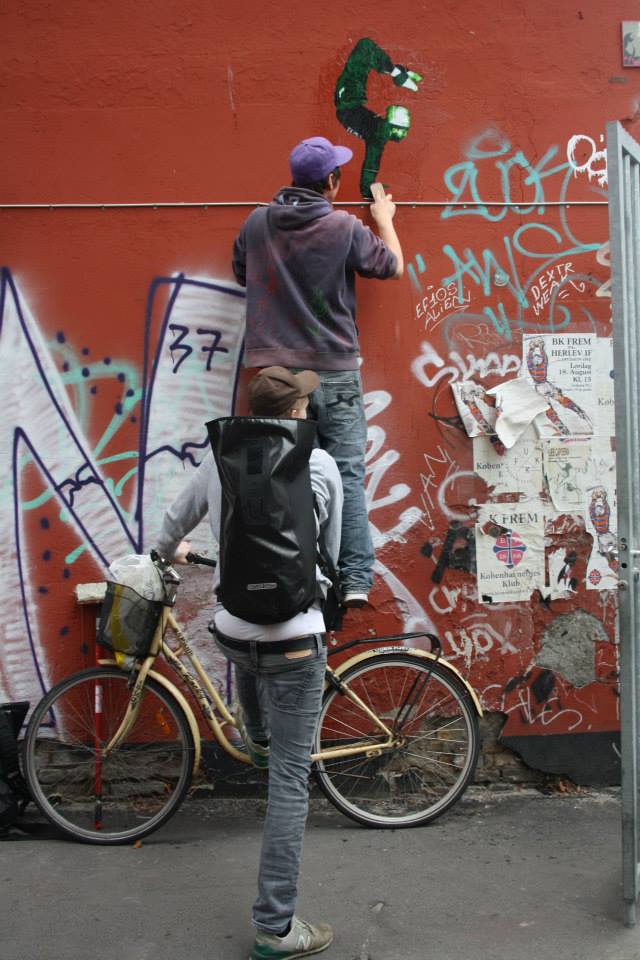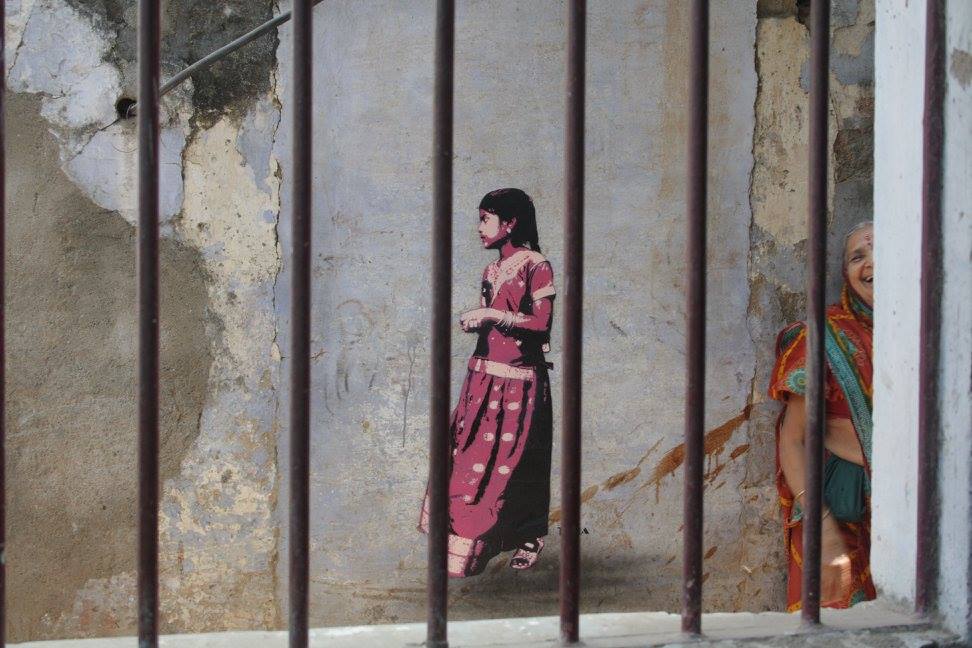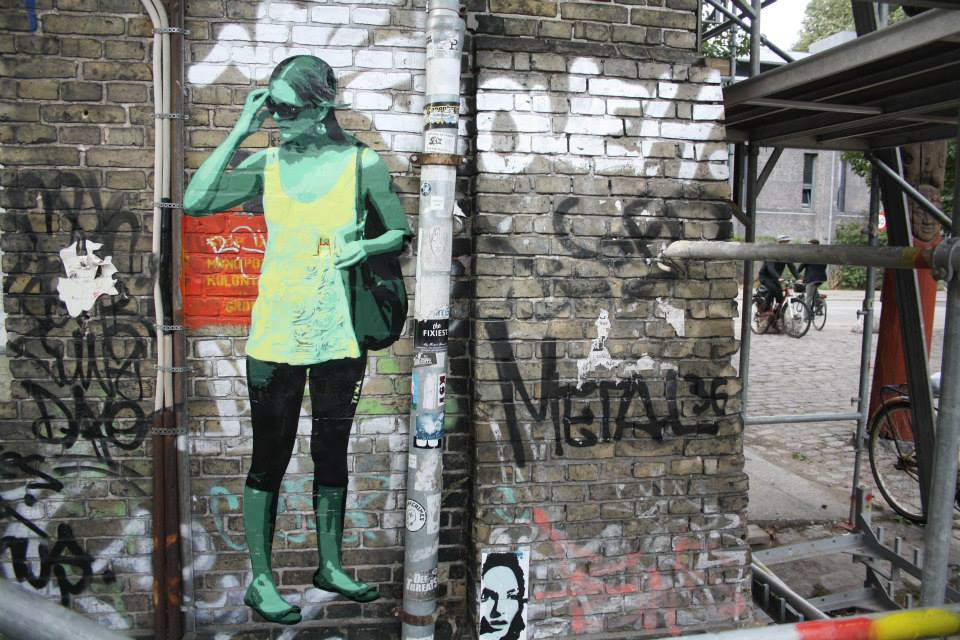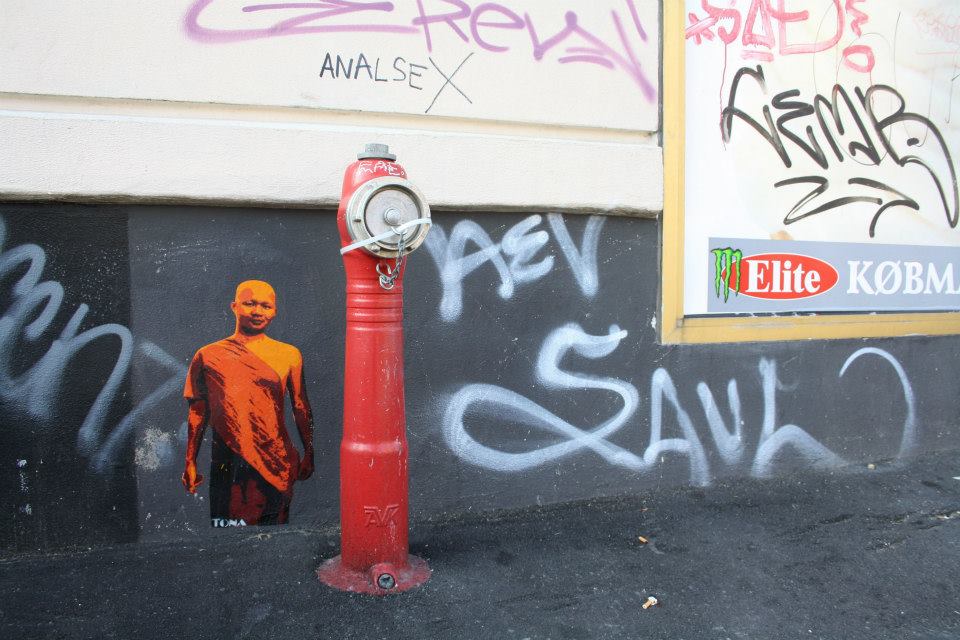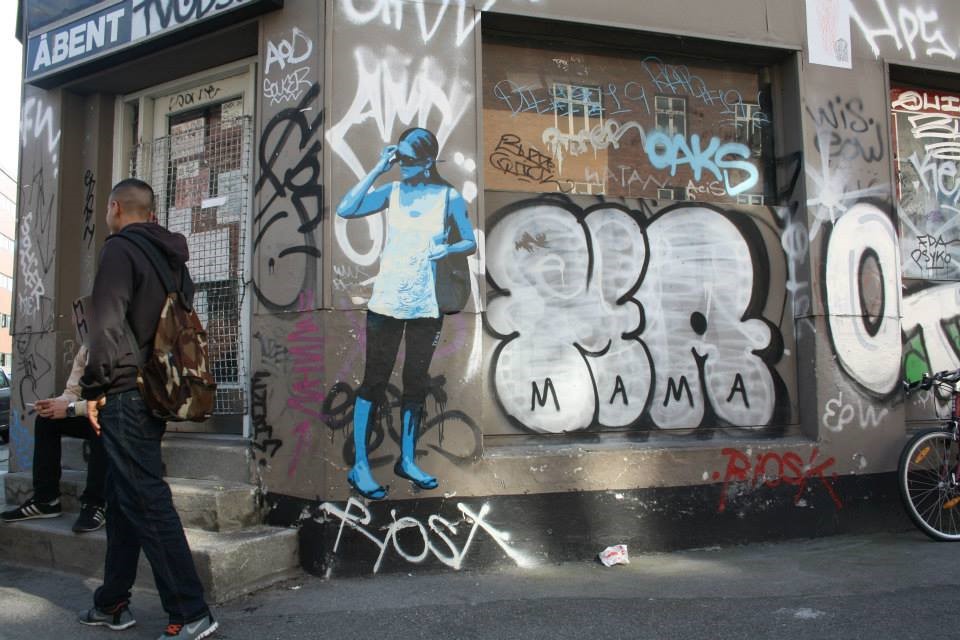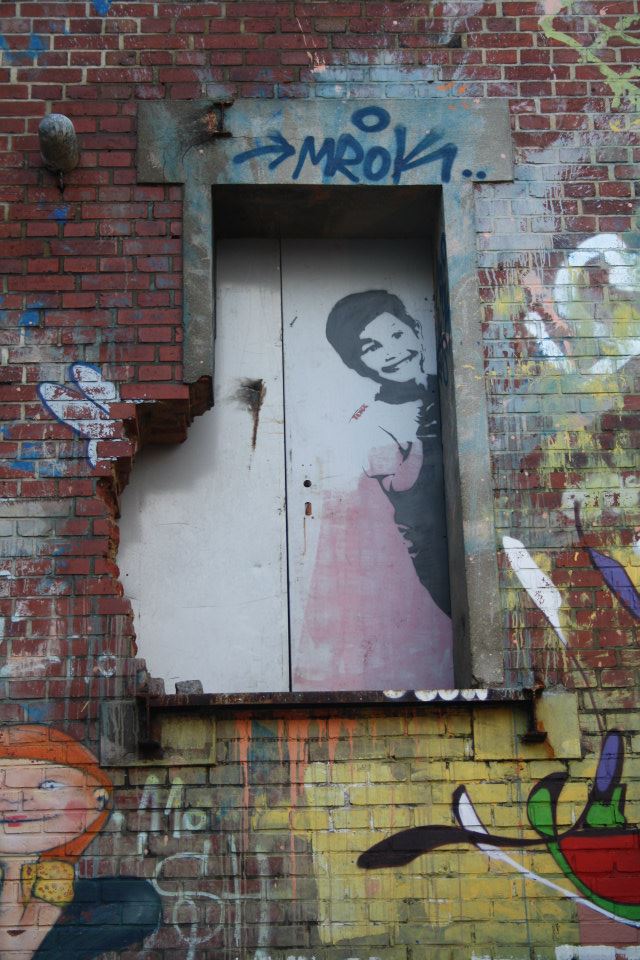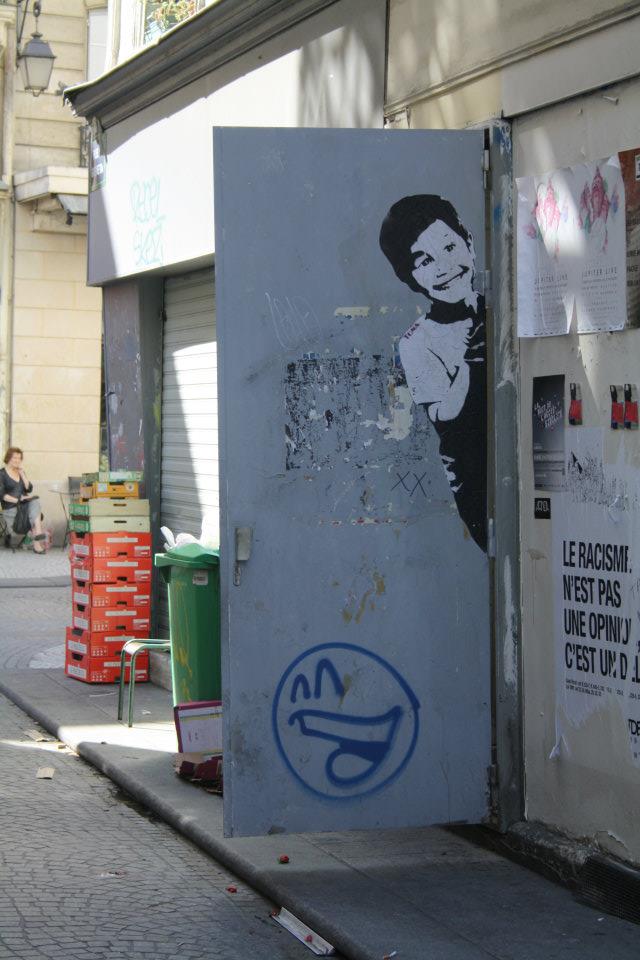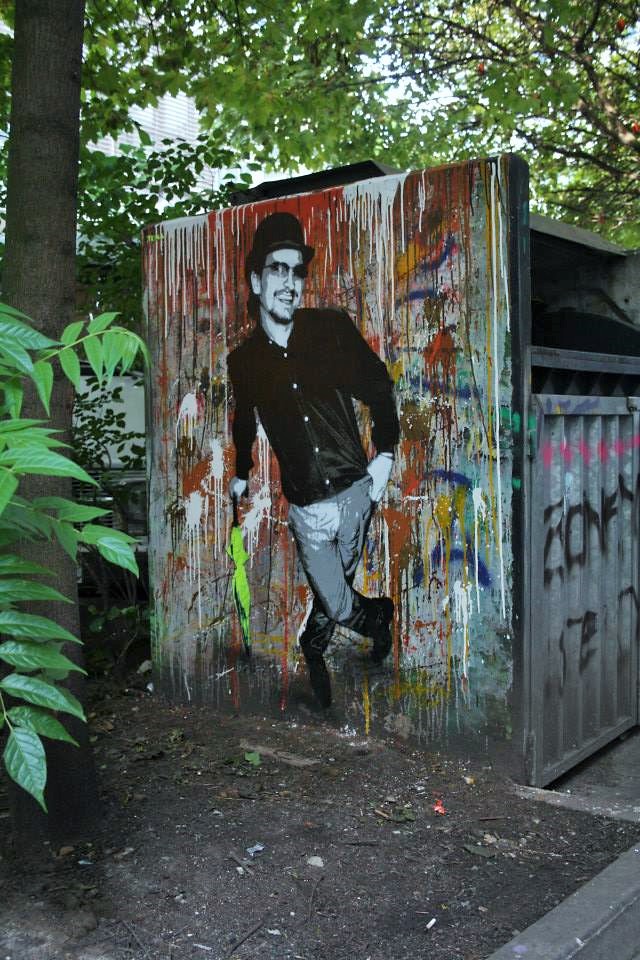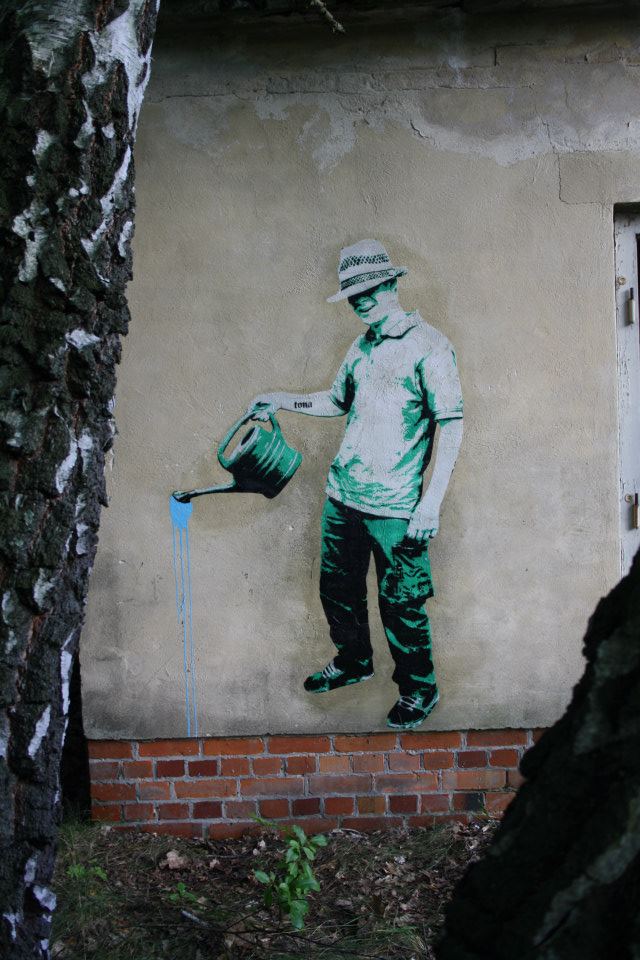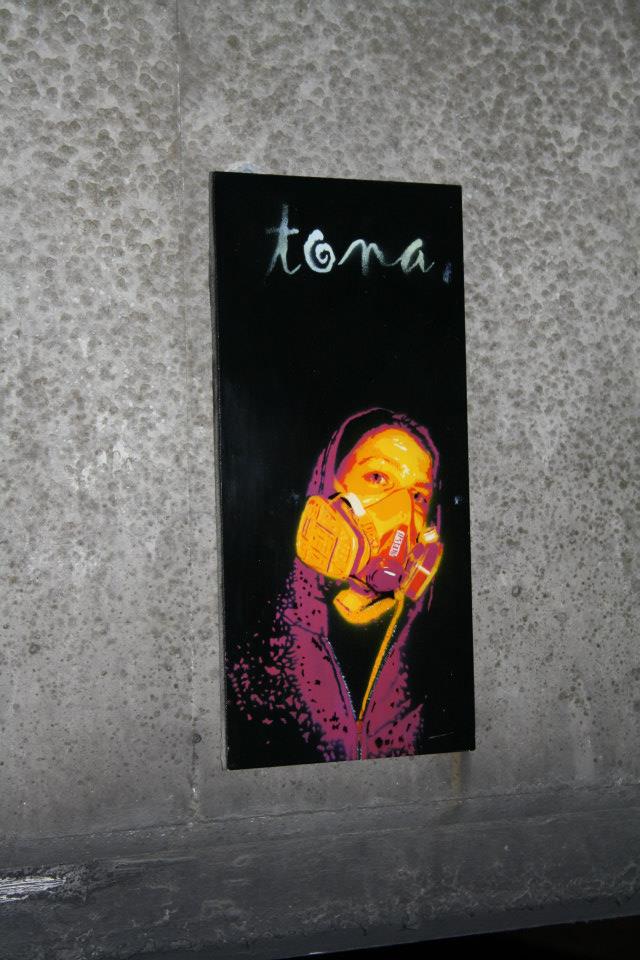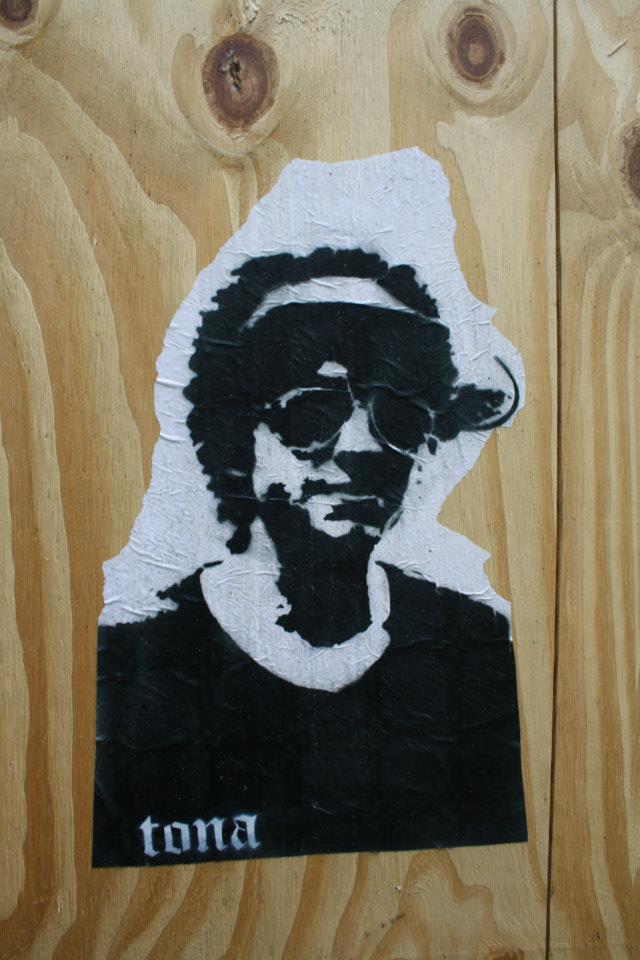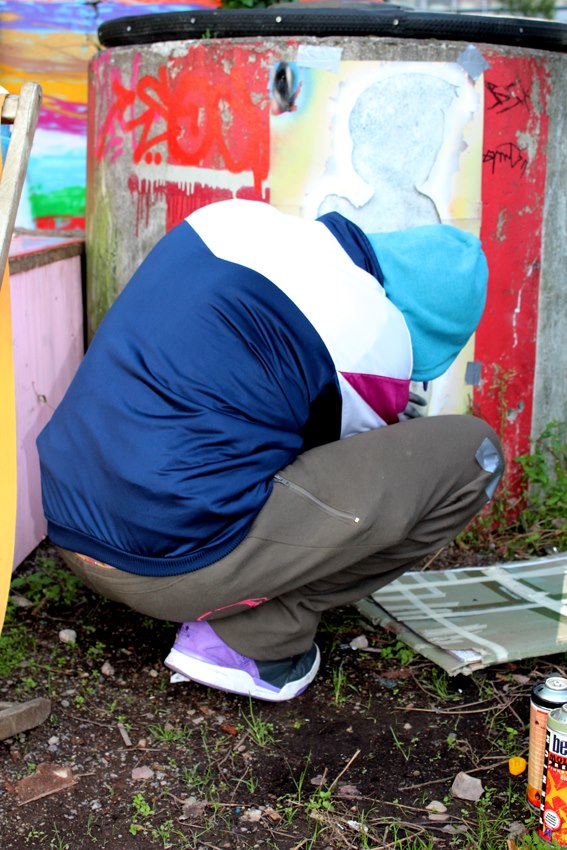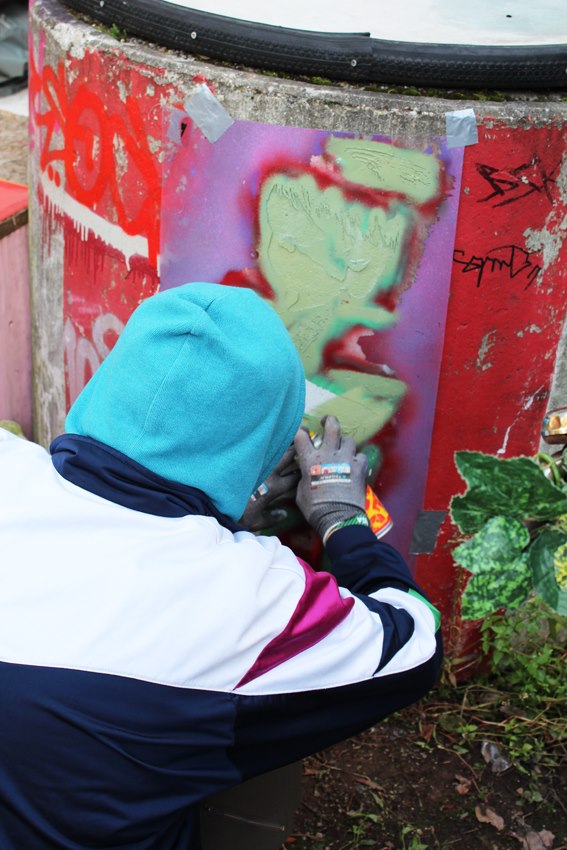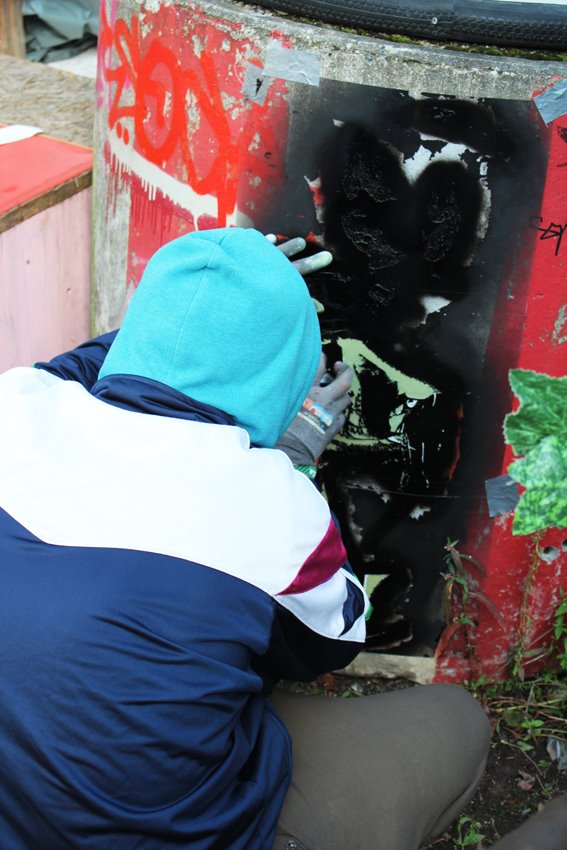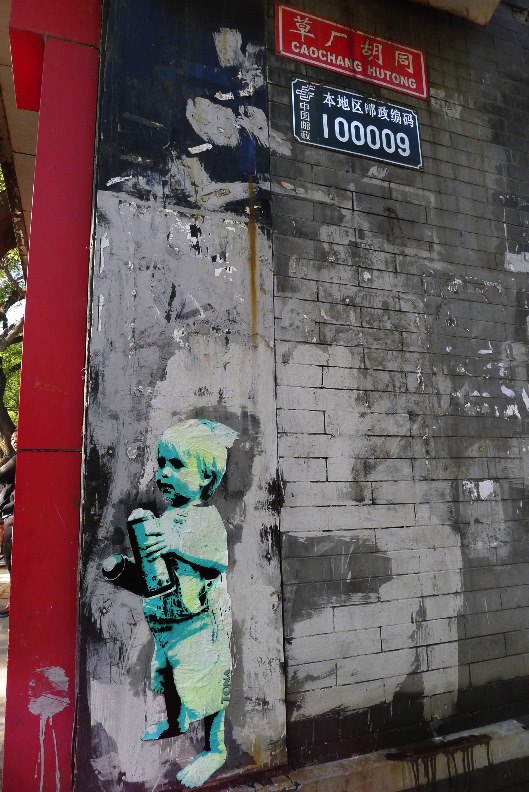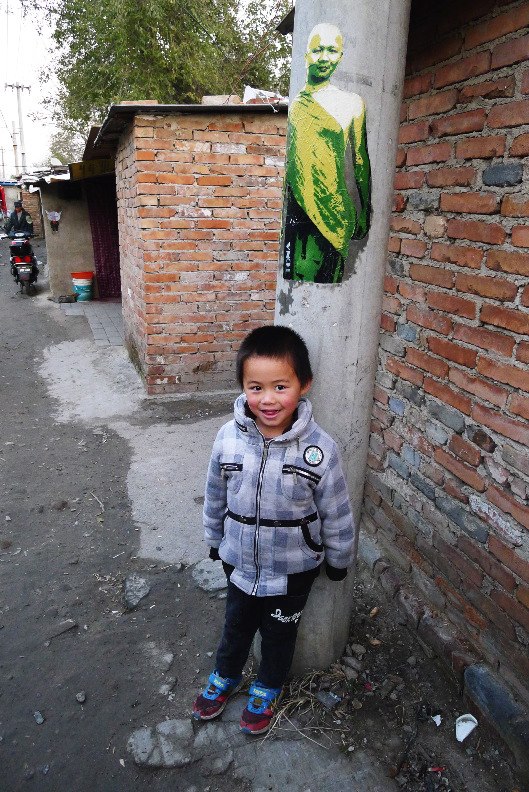You can find the small to large children figures made by stencil artist TONA meanwhile all around the globe on house walls and corners. Again and again the sprayed faces in somtimes simple as well in odd and bizarre places surprise and refresh the street image. The sprayer and stencil artist from Hamburg began graffiti art early on, but then focused more and more on stencil work. Whether on screenprint, on stickers or even on the wall in an urban space, TONA decorates his surroundings and, when travelling, the surroundings of others with small interesting brighteners and artistic delicacies. All you have to do is keep your eyes open as you walk through the city.
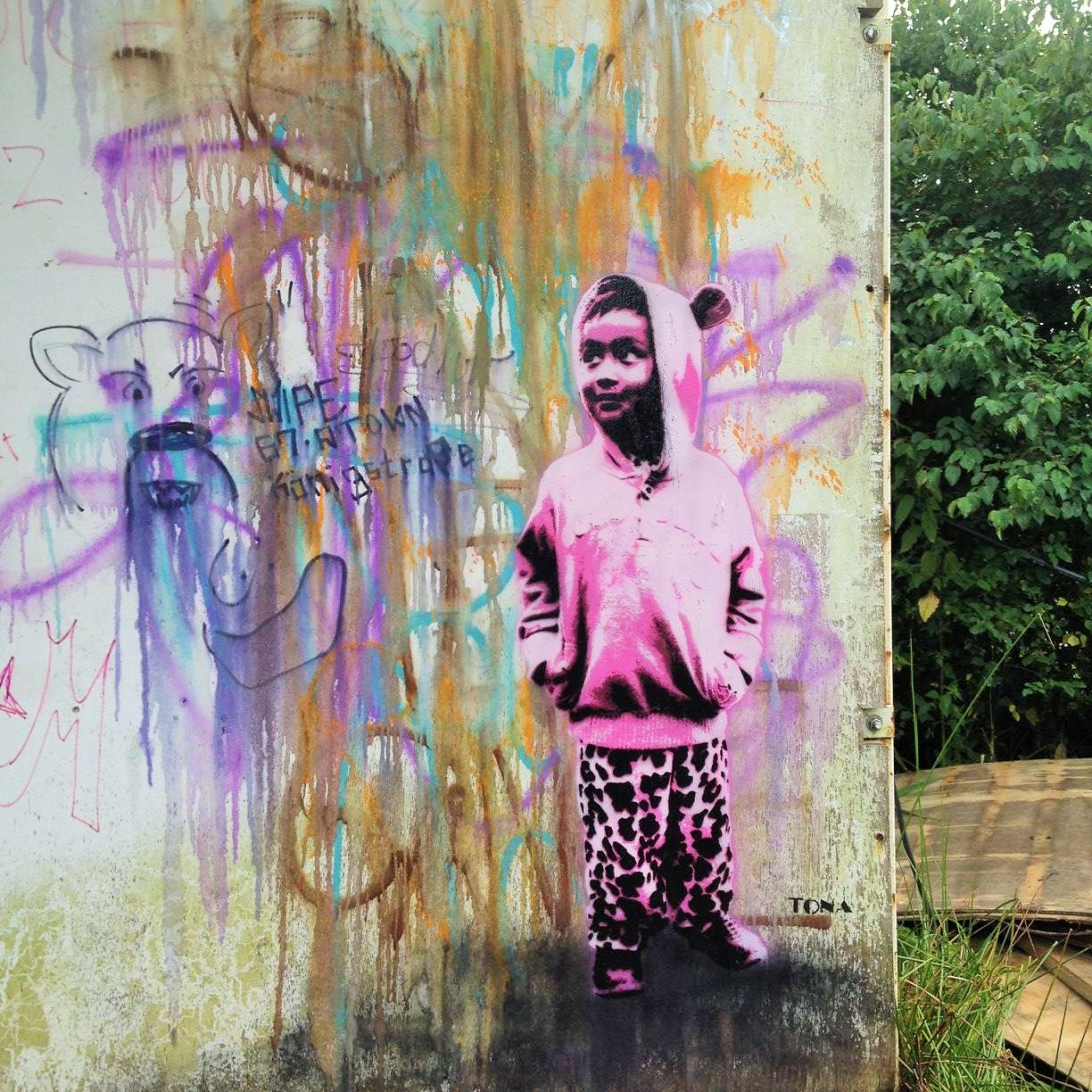
The motifs of TONA vary and have changed over his creative and development periods. Sometimes it was more everyday items, then animals or another time just random friends. Currently the artist mainly paints children figures. TONA has collected all the photos for his basic stencil templates himself, so his motifs are unique and always completely new. Over the years he has already participated in countless festivals, was active in many projects and has given several local and international exhibitions.

In his works TONA gives impulses on an emotional level, or rather he tries to convey an emotion visually. Still it is his emotion that he has captured and expressed in his individual way. But it should remain with an impulse and leave the viewer the space to perceive and interpret him- or herself, which in turn triggers at best again an individual emotion.

In a detailed interview TONA tells us about his development as a stencil artist, his experiences during his travels and the perception of his works. The podcast is in German, but below there is the conversation also written and translated into English peppered with great creations from TONA. [All shown photos, templates and artworks: Copyright © TONA]
How did you get to art and when did you start focusing on stencil?
I’ve always been kind of a drawer. Even as a child I was already interested in that, but also in music. Art is a very wide field and music belongs there as well and also other things. When I was about 15 or 16 years old in school, I came into contact with the Hip Hop culture, after I had been involved with Punk Rock for a long time. Or what does very long mean, I was still quite young. But after that I still felt drawn to the Punk Rock culture for a long time and I also felt like I belonged there or just always felt to be somewhere in between. This used to be a smooth transition. And that’s when I started graffiti painting. I didn’t even see it as art at that time, I just went there and then we painted letters and thought it was cool. Yeah, like when you’re in that age and that young. At the beginning I had contact with stencils through the Punk culture, because there were always demonstrations or political rallies and there they made stencils. So this kind of doing these paintings somewhere was not at all tainted with the term art for me, so to speak. At least at that time.

You did not only stencil, but also a lot of graffiti, bombings and tags. But then it became more apparent at some point that your trademark became these stencils.
Yes, in the end it was so that I took the name from the graffiti and had written it down everywhere in the beginning. And my first templates were also not figurative, but were actually more like a kind of propaganda with my name first simple on stencil and stickers and that went everywhere. Then there came simple characters and figures. This was in a time when you have extremely tried to keep everything as cost-effective as possible. That means, you just went to a Deutsche Post agengy and took stickers there, so these package stickers, or even at UPS there were stickers. It was an interesting time. We tried a lot of different things and have just noticed somehow: Ok, it is kind of a grey zone and you can somehow stick the posters, because then it does not count as a criminal offence, but it moves in the area of administrative offense. And now I’m actually already advanced again, I’m just realizing. Because before I said, that it was not art at all for me at the beginning. Or I didn’t look at it from the point of view of art. For me, it was just a pastime. But then, after a few years, you realize that you’ve created something and you’re starting to do more.

I moved to Hamburg and didn’t have my crew around me. At the time I did a lot on my own and then I also noticed how I went more and more into the figurative and the name became smaller and smaller and at some point only very small in the corner. The figures suddenly take up the main room, whereas in the past it was exactly the other way around. The name was written as large as possible. That’s how it changed. You just went out, vandalized in a certain way and then created something and then realized later what you have created. And then with this realization of it, you say: Yes, awesome! Now I can somehow connect at that point! And then I did it for a long time just for myself. So I didn’t exhibit or sell or anything like that either. That wasn’t my interest at all. My interest was to help shape the public space and I always thought that everyone should do that. So somehow shape the surroundings. Because we all live together in the neighborhoods and walk together on the street. It’s cool if everyone adds a bit of their personal touch to it and it doesn’t all look the same or is grey or full of advertising or other unsolicited visual aesthetics and stuffed with things you don’t really want to have. For me, it is actually logical to start shaping things and the surrounding yourself. So whether it’s political or artistic now, it doesn’t really matter.

You can play a word game on it. So Vandalism or Wandalism. („Wand“ = German word for „Wall“). So with the meaning as a beautiful remodeling of your own living environment by recreating the walls.
It’s not just your own living environment. In the beginning for most people when they start, they mostly design where they are and in their direct radius. That makes even the most sense and the most fun at the beginning and when you can also recognize their works. And then at some point you also move somehow and take it everywhere with you. So for me it is now the case, that if I travel to somewhere then I go specifically because of the art. And I don’t go traveling to the beach or anything like that. I’m just going to paint. Or I’m going to a city to meet people and then somehow we plan an exhibition or a project. So it’s always connected to creativity and you’re kind of taken by this “thing”, but not negatively, more in a very positive way. In my environment there are many people who don’t even know my real name, who only know me as TONA. That’s funny, too. So this just takes over from a certain degree, if you do this for more than 20 years. This identity then also takes over a large part of the leisure and environmental design.

I’m looking at your platforms on the Internet right now. You are currently using mostly Instagram. So this is @tona_one. But there is also quite a lot material on your Facebook page @mistertona.
The thing about the social media, I don’t really use them. I wouldn’t use these platforms as a human being. I don’t think it’s that interesting. But as an artist it has become very interesting, because you have the exchange with other artists and you can contact them more easily. But even people who come across art for their first time have the opportunity to communicate with you. I think the timeline is like this that it started with MySpace, then somehow came Flickr, then there was Blogger, then Facebook and now it’s somehow Instagram. And then the next shit will come and then I will probably just somehow go on this as well. But to be honest, all these figures are irrelevant to me, because you always have to rebuild such a profile over and over again on every platform. And now, for example, on Facebook, I don’t really care about it anymore. But to represent yourself today, I think everyone takes at the moment Instagram. If you get a clue what’s next, let me know!

I’ve got a whole bunch of stickers from you here, too. There was a phase when you started with it. Like the fish can, where TONA is written on it. I think the message has changed with your current stuff. It has much more political or social critical aspects and the current motives are also more people, faces and a lot of children. You collected the templates once on your travels with the camera and then made your stencil templates from the photographes, which you then painted again at other places. Sometimes quite large as a house wall or even small on a sticker.
Yes, with the stencils it was like this, so there was just no Photoshop yet. You kind of took it yourself. And then at some time came this Photoshop and you played around with it too. Or Gimp or other programs. You kind of just took a photo before and then worked with the photo as a basis to make these templates. I believe that this also somehow resulted from the fact that I used exclusively my own photographs. At the very beginning I might have taken something from the internet or from a magazine or somewhere else. Or I still get good pictures from some people today. But I just think it’s totally awesome when you have your own motif and you can be sure that nobody else has it. And that themes on the motives are also relatived to what I experienced in that moment. I’m just traveling around and I’m on the go or meet people. And then I just take photos and through these photos I actually reflect what’s going on around me. And when I’m painting mainly in Asia right now, there are just a lot of kids on the street. This does not mean that they are necessarily street children, but they spend a lot of time on the road, if they have little room inside, then they are of course outside. The interesting thing is, if you use such a spray can, then especially the children are first at the start and are completely fascinated by it. So it just happened that I mainly started to portray these children too. And I’ll let them travel around the world like that.

I am not at all concerned with a socially critical or political message now necessarily in my art. I am political, but I think that if you want to achieve something politically, then you have to do something like a demonstration or somehow develop ideas and concepts together, try them and see if it is possible. In art, it’s actually a more emotional thing for me. That means, if I take these photos, sometimes it doesn’t even take two or three days, then I already develop a motif on it. And sometimes it takes a few years. I want to freeze this emotion somehow in the template and then try to check with my environment in a nonverbal way if this speaks to the opposite. Is there some kind of communication? Do they feel the same as I do when they look at it? Or is it completely subjective, because only you have experienced it yourself? So it’s such a process you move through and you don’t even get out of your subjectivity. So I mean, of course you can always criticize everything, but you have to try something in the ideal case to see if it works. And if it works, then maybe it’s better compared to what you did before and then you can adapt it in a way.

At the moment I don’t know where I will go with my art and where it will take me. I had a phase at some point, where it was more about items. There was always the comparison with the name: “Oh yes, TONA and tuna, that’s very funny!” So I thought, okay, then I’ll do this with the tuna can. But I myself don’t even eat any meat or fish or any of that stuff at all. So then it is kind of a persiflage, so you make fun of yourself, because it’s funny at some point and because it also stays with people. The other day I met an old colleague who said: “Ah I remember, you’re doing this thing with tuna stuff, right?” Somehow it just stays with the people an that’s also funny. Then you have to ‘fuck yourself’ sometimes. That was the origin of that can. I also had a phase, where I portrayed many animals, because at that time I was on the opinion that animals are the better contemporaries and humans are actually just annoying. You just have your phases and then you can go in one direction or another and row around like this. Somehow I’ve noticed over the years, that as a person you always run around. You build up these shields and these patterns of behavior, you show hardness to the outside and I always like to call it “masks”. And with children, it’s ruthlessly honest and maskless. I try to reproduce this perspective which I see in the photos somehow emotionally with my art. Because that’s exactly what you lose somehow along the way becoming an adult. This also requires a lot of interpersonal trust, so that the people can also tolerate this form of direct emotional charge.

I called it “socially critical” earlier, but I understand it better now the way how you describe it and I’m just looking at some pictures of you. So you can already say, by discovering some of those figure there also comes an emotion with it. You mostly just have to smile when you walk along the road, look a little to the left and then suddenly on a house wall is such a small guy and smiles over. Or between some corridors, suddenly playing children with a football appear on the wall. But there are still some pictures which really make me think. For example the one with the yellow sign, where the barefooted girl doesn’t smile, but rather concerned or almost worried. In the background there is also this word “problem” on the sign. For me this one looks like you draw attention to problems of children. So maybe the funny ones remind you on being a child and the parts you often forget and lose when you grow up. But there are other artworks like this one which also point out, no matter what problems are currently prevalent on earth, whether it is a war, an economic crisis or a pandemic, the children are definitely a group that suffers first and most under.
Yes, I mean, nobody really listens to them either. It is a well-known societal problem that children, but also older people, are not properly listened to in their form, as they formulate problems, because they are often more emotional. In between these groups we average adults are all just, so I call it now cautiously, in a ‘certain way conditioned on a social consensus of dealing’. And no matter where you go, this factors change too. If you’re on the other side of the world, then maybe something that’s taboo here is all right there and then there are gestures or things that you use every day here, which are then somehow taboo there. So everybody knows such examples, but with other behaviors it is difficult to allow it, if it is emotionality. Like men don’t cry. It’s always such a thing. Most of the time as a child, you are influenced by your parents and society. And this is the first imprin and children first imitate everything they see around them. They see and percept everything for the first time and also think, that’s the way how it is and has to be. That’s why it’s often so ruthlessly honest and maybe sometimes a little cruel. So kids don’t always deal well with each other. Because they also copy what they find outside. But basically you can say yes, each of these motifs has a different story. And now I could tell you about every motif, where it was and what happened and what the circumstances were. Then you could grab this moment and emotion a little bit more and better. But my intention is actually not the origin or the whole context, much more only that emotion. What effect does it has on you? What does this matter to you? The way you described it, this is the interpretation of you. This may not be the case for everyone, because some people might not even want to percept or interpret it. There are plenty of people who can feel it and others who don’t want to react to it. I know this from myself. Sometimes I don’t want to take myself out there and avoid thinking about stuff. As well sometimes you just can’t live or think it out in the moment. But that’s exactly what the child just does. Or the old person who does that too. There is a different approach to it and more emotionality. Maybe it is the case with old people that they say: “Yes, it doesn’t matter now!” And as well the case with children, who say: “Yes, let’s have a try!”
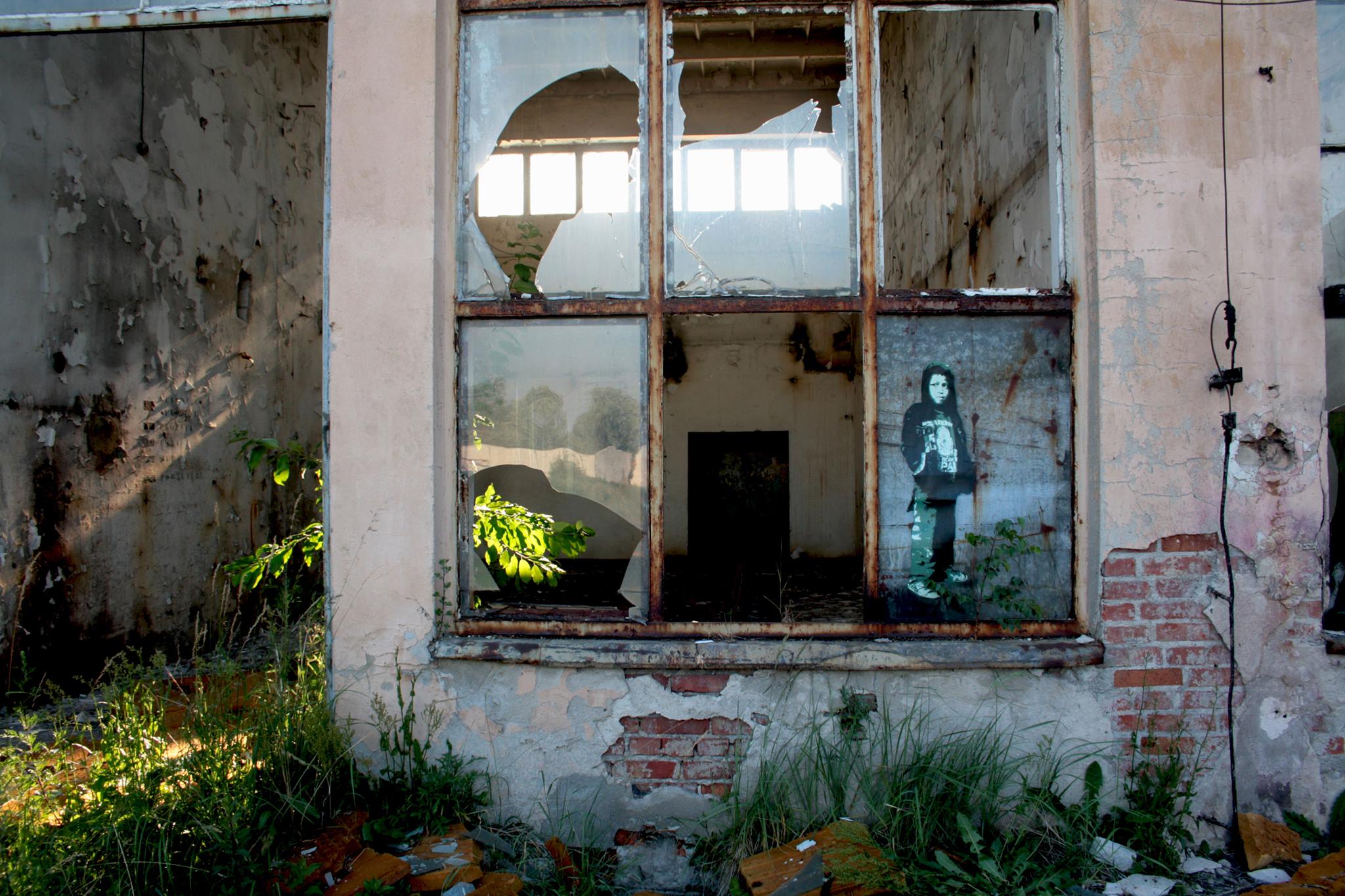
It is not that art has a direct task because it is just simply there and everybody can do something artistically, but there is a level which is open and free to the viewer. And this has different levels, you could call it meta levels or whatever. But the first one is just looking at the picture like: Ok, those are the colors and it’s this or that style and so on. But then in a next step you can also think about the creator’s intention and the background story. The individual story behind is not that much important with your art and your intention. You know the story, but the message you want to give is more the pure emotion. And here it goes one level further by transporting a feeling and triggering something individually in each viewer. For me those two aspects of the children stencils came across to me quite clearly. One is, remember the child in you again. Do you remember what it was like when you were a child yourself? So to the viewer to think a little more about it. And the second, seen globally and internationally: Think about the children in the world in general.
For me it’s always super interesting to hear how other people perceive it. I think that’s a good thing and the interpretation is good too. I always think everything is right in some way. So everything that you can see, as long as it is based on the emotionality, communicates with you on the emotional level and triggers thoughts in you, that’s right for now. So it is also the case that not everyone can handle it. There are also situations where artworks disappear very quickly or some of the eyes are explicitly attacked, for example painted over or scratched out or things like that. That happens too. So of the viewers don’t get along with what they are seeing. Because then something happens to them and they see perhaps something completely different in it compared to what I feel in it. So I try to have an emotional conversation with the viewer, so to speak. And it seems to work with you right now, because you say: Ok, so I start thinking about my inner child and I also start to think, hey, you actually have to look at the children of the world more in general. That is your interpretation and it is right for you. Because it came to you emotionally. But even if someone afterwards has an emotional reaction in which he or she is actually frustrated and then somehow destroys the art, that is also an emotional act. That doesn’t mean that I’m happy when that happens.

But for you it is more about giving an impulse one step ahead of the interpretation. Like the one I just had for myself. So your intention is more or less the emotional impulse itself and then it lies with each viewer. You don’t want to pretend too much and the impulse shouldn’t be instrumentalized. Whether that has something to do with Corona or with refugees or whatever. At first on these motives they are just children.
Exactly. And they have a look or a gesture or something. And that’s how you know it. Then you also notice that you start to interpret. That is your way of analyzing that and that shows you a lot about yourself. That is generally also the case with imagery. It’s not like for example with music, because there you have lyrics which tell you what the song is about. So whether about love or philosophical topics or whatever, but words convey to the listener what it is about. It’s not that easy with pictures. So let’s have an apple now for example. And you don’t like apples, but I like apples. Then I see a picture with an apple and I think it’s great and you see the same apple painting and you think it’s bad. And there we already have the problem because we only see the image of the apple and the chain of associations is that you don’t like that and for me it’s the other way around. So I think it’s good and you think it’s bad. This is just a simple example and it’s a little more complex, but it’s difficult to get a broad audience with imagery, like the audience with music. Because everyone starts to interpret for themselves as soon as one perceives it. Of course there are as well lots of people who just walk past it. They don’t even see the work of art and just look at their cell phones. They don’t even see what’s going on around them and they also have no need to somehow perceive or to shape their surroundings. Their surroundings have been digitized and they are not interested in the reality around them, because they are somehow building and constructing on something elsewhere in their own way.
Maybe they are just looking at your photos on Instagram in that moment.
That would be, of course, a funny paradox. Hahaha!

So first of all it is important that people get reached and that it triggers something in them. But as you said, if someone gets angry and starts scratching something out of the picture, that is of course not intended.
My main intention is not that I want people to get angry. Of course that’s not the intention behind it. But if the artworks trigger something like that in people, then that’s okay too. In the end everything is ephemeral and if you put things up in public spaces, then even more. Because that is somehow not only dependent on the time and handling, but also on many other influences.

Yes, there is a fluent change in the streets. New stuff is constantly being painted on previous ones or buildings are being torn down. Graffiti and urban art are often only there for a moment.
Well, the people are doing it so that it triggers a certain amount of attention or a certain amount of joy in doing it. So you can paint on the off spot, then I’ll talk about the joy. You can take a whole day and it’s really awesome. And then you do it because you just want to paint. But you can also look for the spot where it has to be quick and then you might also know that it’s gone after three days, but it might be in the press and gets highlighted. Everyone is somehow different in the way of doing graffiti. The one wants more attention, the other wants to go into the creative process as long as possible. It is different with each artist. And some of them also want to combine all of it. Everyone is different. This is similar to what I just said about the individual feeling. You can’t tell people what to feel when you give them a feeling. If I could send you an emotion now that you cannot describe broadly, and you could then feel it briefly, then maybe we could both try to find words for it and to describe it. But when you have to paint a picture of it, it becomes really difficult.

We talked as well about the differences whether you paint in your studio or in your neighborhood or when you paint something on someone’s wall or then when you are on a trip. Because your inner mode is different. When you are at your place and paint you have no time pressure, but when you went to Japan for example, you knew that you only have a limited time and then have to do as much as you can. Because the journey was short and you wouldn’t be back anytime soon.
Yes, of course that is always a factor if you haven’t been somewhere before. Then of course there is always a special motivation to leave a trace somewhere. And I have to say, the older I get and the longer I do it, the less important is the choice of spots to me. So that was much more important to me in the past, the spot. And today it is much more important to me to somehow leave a trace wherever I go. So that has become a much bigger aspect, because then I just know, as you said: Ok, I have now only four days staying here. So then you just walk around for three days. Or just completely all the time. You are always ready to paint and also do things that you wouldn’t do in your own neighborhood. Like you approach people and say: Hello, I’ll do this and that. And you might show people more things even if you are completely strangers, especially when you are in countries where you really don’t want to get behind bars in prison. Then sometimes you just have to ask. Something you might would not do if you are around a place where you know exactly how things are going. You have to be flexible about that. But of course the motivation is higher when you know you are somewhere where you haven’t been before. Sure!

Describe a few of your trips to other countries and what it was like to paint there compared to Germany or Europe. We already mentioned Japan, but you also traveled a lot in other countries in Asia.
Yes, first of all the temperature difference in Asia is a factor. That is not to be despised, especially if it is about paint. But it also really depends where you are going. There is always a possibility to find equipment, but it is often very difficult to get cans easily. When I was in Nepal, for example, there were cans, yes. But there were no appropriate cans to really paint multilayer stencils. To get material to paint multi-colored stencils, that’s a bit more difficult. Then you have to rethink a bit sometimes. That’s the one aspect where you have to improvise a little sometimes. But there is always somehow a way and you always somehow get it done. So according to the motto: Where there is a will, there is also a way! And this developed mostly also very interesting. It was often the case, especially in India, but that I started painting somewhere and people really liked it and came watching. And there are always a lot of children there. Suddenly it often became such an event space. Then even the tea seller comes and sells his chai and you are just surrounded in a bunch of people. Everyone is watching you and thinks it’s totally cool. And that versus Germany, where people first ask if you have a permit? And if not, then they call the police here immediately. That’s more the style here. It is also sometimes very interesting that the people there have a completely different way of dealing with it, because the blatant sun and a monsoon will completely fade and wash the house wall color in only a year or two. Here in Germany it would still look nearly the same after ten years. That makes a huge difference. A big factor is also that you have such a large number of people. India is very populous and people are generally more used to human contact. While around here you can really sometimes walk on the street and see no one. There is no real contact here. And I think this also makes people there less afraid of making contact with people they don’t know yet. So it doesn’t matter whether you are a foreigner or just someone from the next city. The typical kind of villages are a bit similar everywhere, no matter where you are. But in the big cities it is very different. Walking through a city of 20 million inhabitants, that’s tough. There is always a enormous bustle of people and this extent seldom happens in Europe.

It’s almost like a culture shock. At home you get regulated the same way the whole time. And art is not seen by many, but they only see the law and rules. “Does this guy have permission for painting there? And is he violating something?” Some can only look at the work of art if they know that the artist has permission to do so. Then maybe they would start looking at it. Of course there are also areas here in Frankfurt where more urban art can be found and in Hamburg it is also the case that residents often see things differently and more colorful, but you can still see this difference to many other countries like in Asia or South America, where a much larger part of the population perceive these images and this art more positive and are directly open for it.
Yes, you could say that because in these countries this form of urban art doesn’t even exist in this way. It is very clear why that hit Europe like that, because movies like Style Wars were shown on public television. And that happened very quickly after release. As a result the young people here also quickly took up. So they are the old schoolers today. And that’s why I grew up naturally with graffiti around me as a teenager. But I went also sometimes during my travels through areas where there was no streetart at all. There wasn’t any graffiti yet. Then I spent a day painting there and they asked what am I doing there. And then I said, I am putting my name here with an artwork. Then they responded like “Wow, cool!” or “That looks very interesting!” They really see the calligraphy, the typography and somehow the flow. And because they may not even be able to read it, they often only see it as a picture. I did the same as a child, because of course I couldn’t read the graffiti at the beginning either. I only saw one picture there, but I thought that was cool. So colors and flashes, that’s interesting. Sure, you can read Bombings, that’s how they make them. But that big fat burner somewhere, you didn’t have access to it even as a child. There was nobody there to explain it to you. Except that the parents said it was bad. So every culture has its pros and cons and you find similar situations in other areas. You might find an openness to imagery, but then you find a closeness to nudity or something else. So I hope that at some point in the future we will all be citizens of the world and that we all somehow have more understanding and tolerance for one another. Then it is actually only fair that everyone who chooses a form of expression must somehow reflect in different views. Because if there is a color for example and it is the color of happiness in one country, but the color of bad luck in another country, then you have to consider that. Or the number 13, which is also a good example. Some say the number brings luck, others say it is bad luck. That always depends on where you are. That is also what I meant earlier by the interpretation. This always works relatively individually and not generally applicable.

You also have to move away from generalizations as far as possible, because you have to see the different human being with individual and subjective perceptions.
Yes, and unfortunately we can’t get out of that subjectivity. You say something in words, and sometimes it´s possible to empathize with it. When it works it is, because I may have experienced it or something similar too. And then I can build on that. Like in a movie, when you see a scene and something similar happened to you and you really feel it. And the director may not have thought of that at the moment, he thought of something completely different, but you are now feeling your experience. I think it’s always very difficult for people to even take on such a form of real objectivity. There is only this group objectivity and I usually find it very unfair. You just have to keep saying to yourself: ‘Ok, wait a minute. I have to somehow try to allow any form of interpretation, which also means the opposite of what I see.’ Of course as an artist it hurts if someone deliberately destroys my art in some way. But I also put them on deliberately and then at some point it is put into perspective again. Because he or she might be in another mood and really wants a white wall and thinks that is cool. Then I just have to accept that they have their rights, even if they don’t suit me, but then maybe they’ll remind me of some parts of me where I think I’m just as stupid and pedantic myself. It’s always about reflecting. I think the whole of life is a permanent reflection and all these things that are suggested to you that they are relevant, so these worldly things, you can’t really use them anyway in the end. That’s why the old people and the children are so relaxed. I think these adults just run after every crap. Because then you get some things and because somehow you can find other things great in this short period while you are there. Then you spend a few years doing those things, then you get old and you realize that now you have so many things. And then you ask yourself: What did I actually do in my life?

Yes, gathering too many things. You actually don’t really need any of that. You think then: What have I accumulated, that’s way too much!
You also only borrowed the body in one way. So you have it and you can rock it off if you feel like it or you can also take care of it. You can love it or hate it. You can practically do what you want with the way you are in there. But in the end, you can’t change it. You can just work on it and work with it and accept that. In the end you can get the best out of it and reflect on it. And ask yourself: ‘How do you get rid of the things that are bothering you?’ Through another reflection and through another perspective. I also offended some people with one or another motif. Some have said: “But before you did something with happy elements and that spoke to me. But now he looks really grim and I don’t like that. I don’t like these emotions.” Then I said: Yes, well, but it’s just an emotion. You don’t have to like it, but you also have to say, that children are sometimes grim. Adults too. The world is not always fair and it is not always what you want it to be.

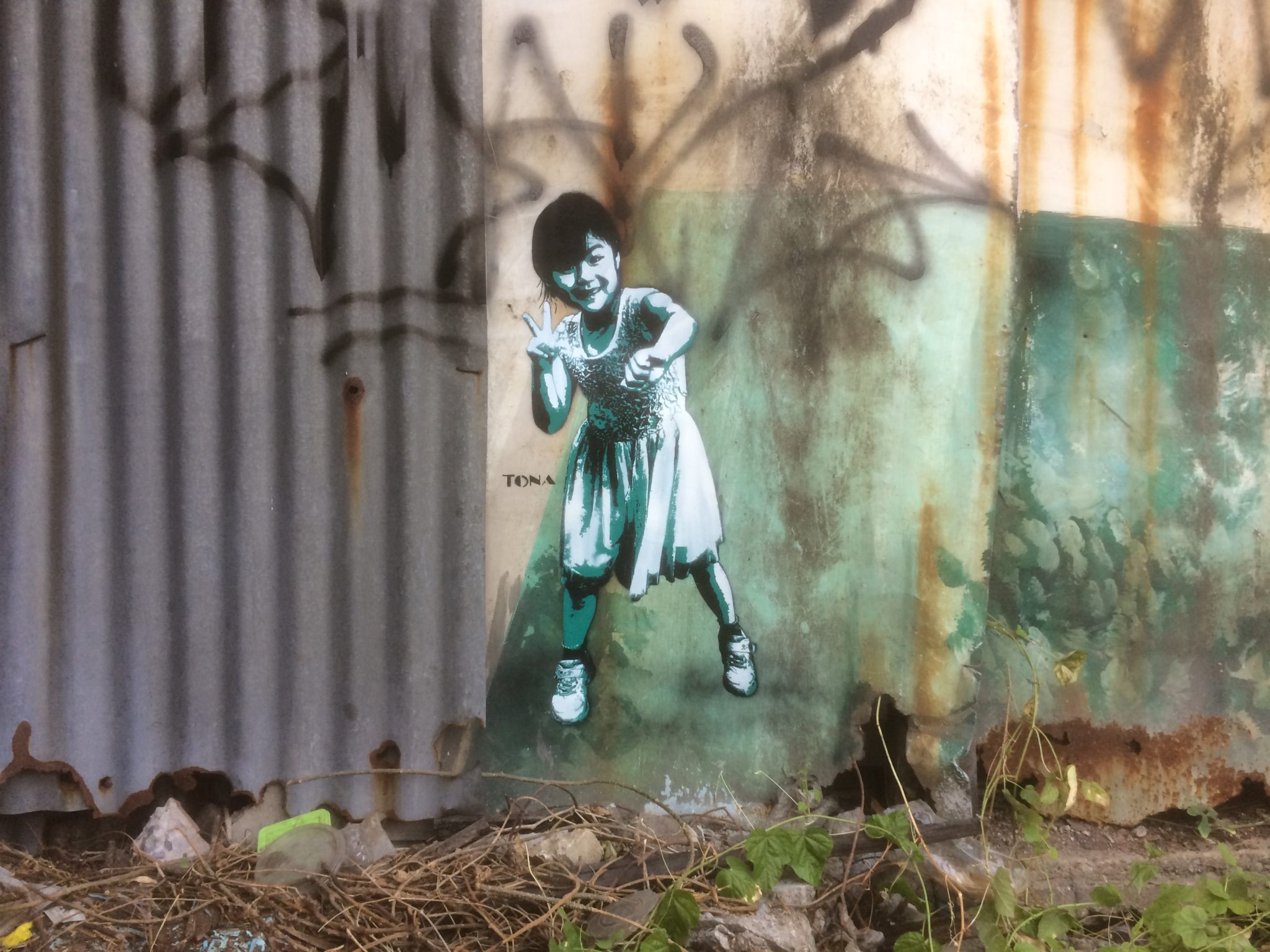

INFOTHEK
![]() Email: tonastreetarts@gmx.net
Email: tonastreetarts@gmx.net
![]() Facebook: https://www.facebook.com/mistertona
Facebook: https://www.facebook.com/mistertona
![]() Instagram: https://www.instagram.com/tona_one
Instagram: https://www.instagram.com/tona_one
![]() Artsper: https://www.artsper.com/en/contemporary-artists/germany/22888/tona
Artsper: https://www.artsper.com/en/contemporary-artists/germany/22888/tona
![]() Salzig Berlin: https://salzig.berlin/kunst/tona
Salzig Berlin: https://salzig.berlin/kunst/tona
![]() Singulart: https://www.singulart.com/en/artist/tona-15781
Singulart: https://www.singulart.com/en/artist/tona-15781
![]() Style Wars: http://www.stylewars.com
Style Wars: http://www.stylewars.com
![]() Urbanshit: https://www.urbanshit-gallery.com/en/shop/category/artist/tona
Urbanshit: https://www.urbanshit-gallery.com/en/shop/category/artist/tona
![]() Foto Credits: All shown photos, templates and artworks © TONA
Foto Credits: All shown photos, templates and artworks © TONA
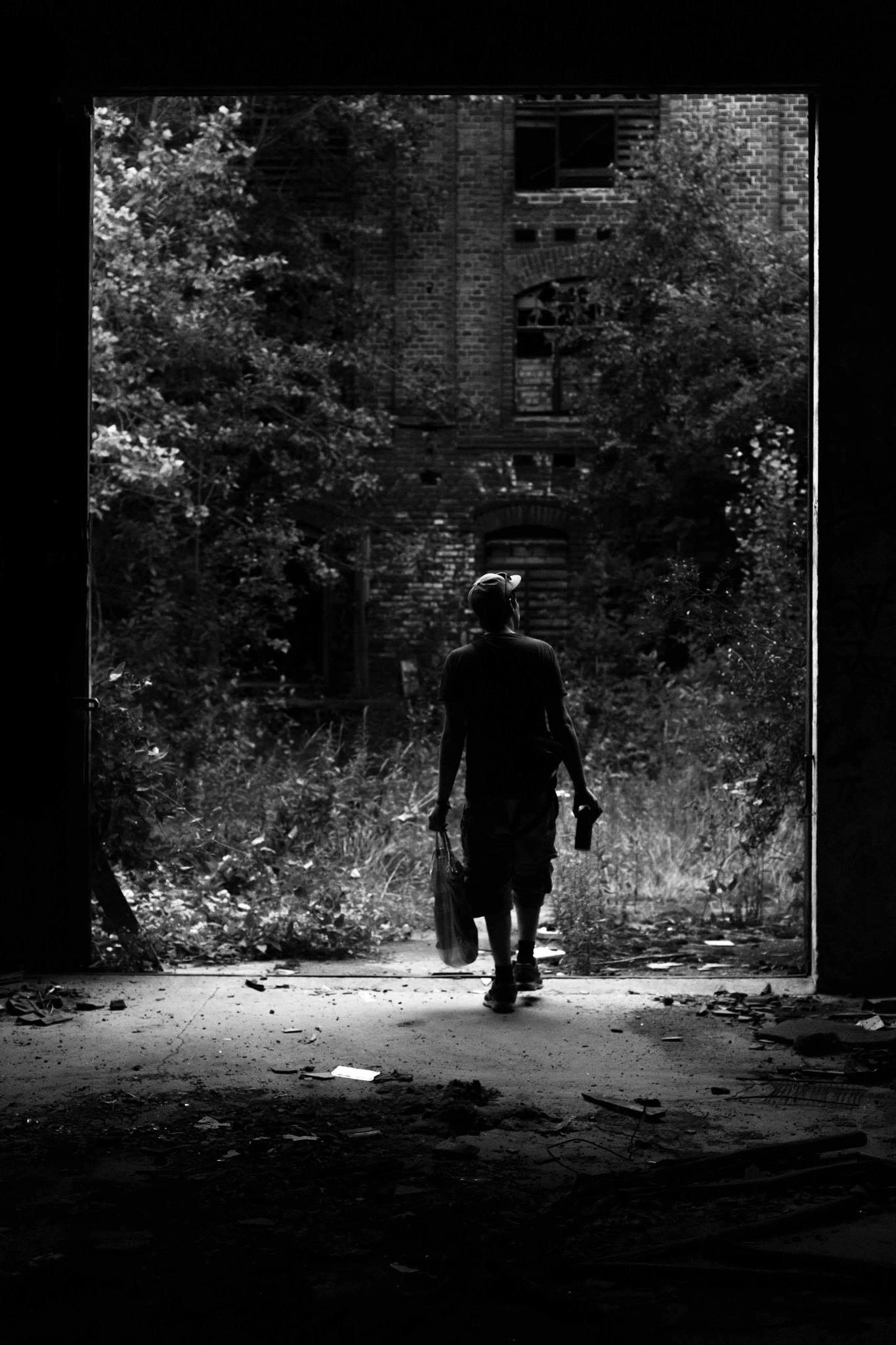
![]() Foto Credits: This last one here was take by © Peter Grünheim.
Foto Credits: This last one here was take by © Peter Grünheim.
